Authz as a dev workflow • Dan phrawzty Maher • Cerbos 1 @phrawzty // cerbos.dev
Slide 1
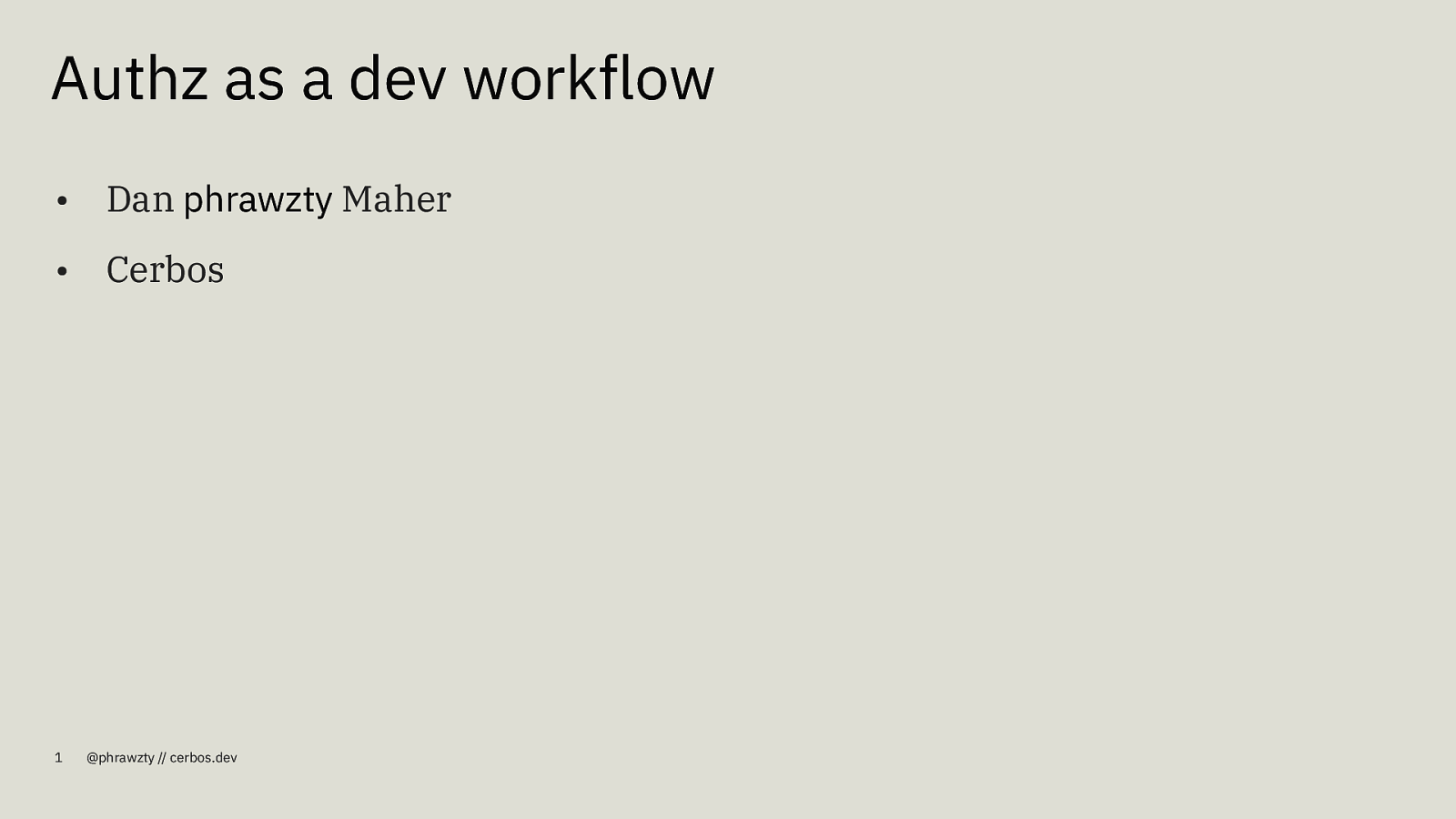
Slide 2
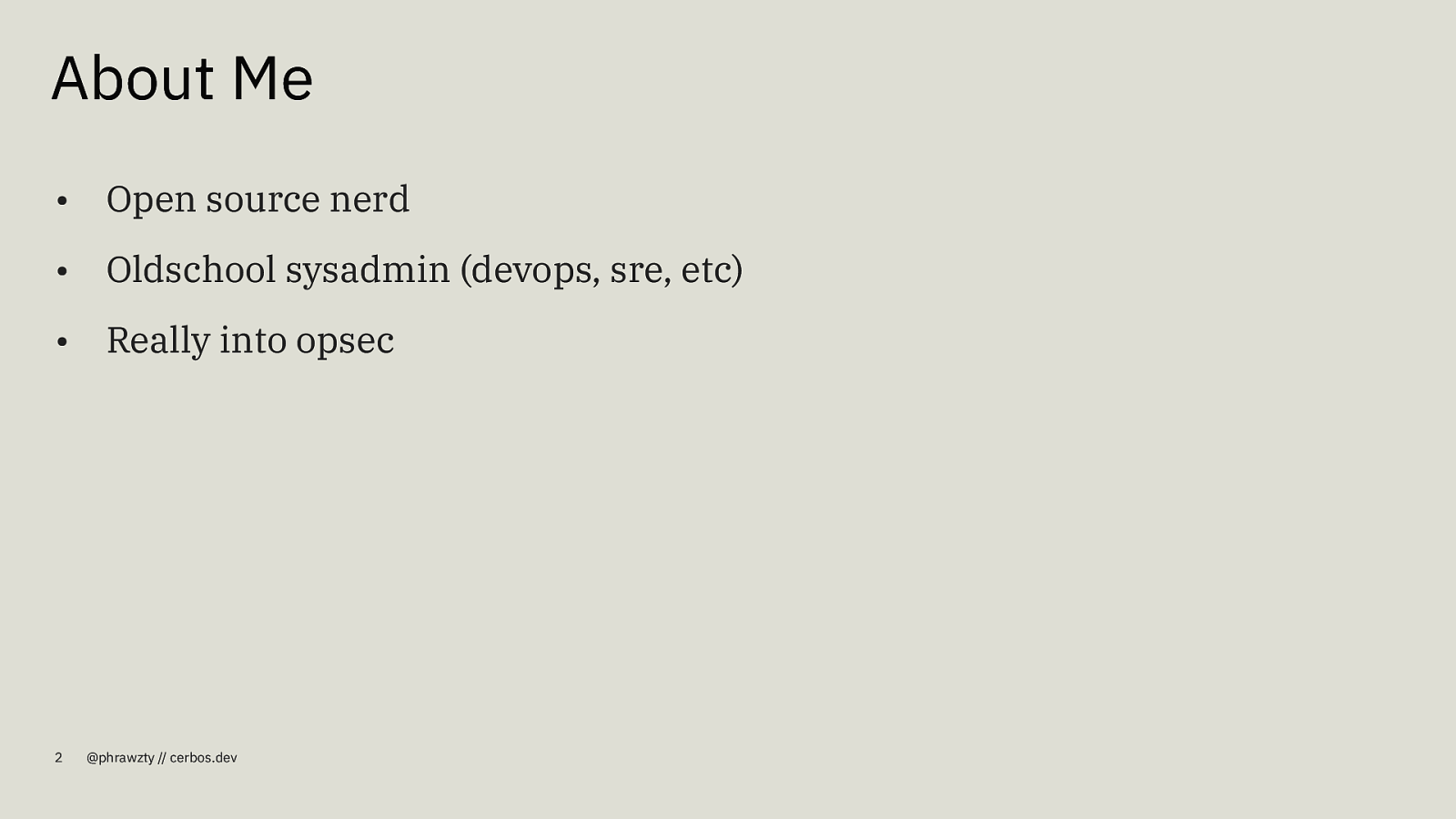
About Me • Open source nerd • Oldschool sysadmin (devops, sre, etc) • Really into opsec 2 @phrawzty // cerbos.dev
Slide 3
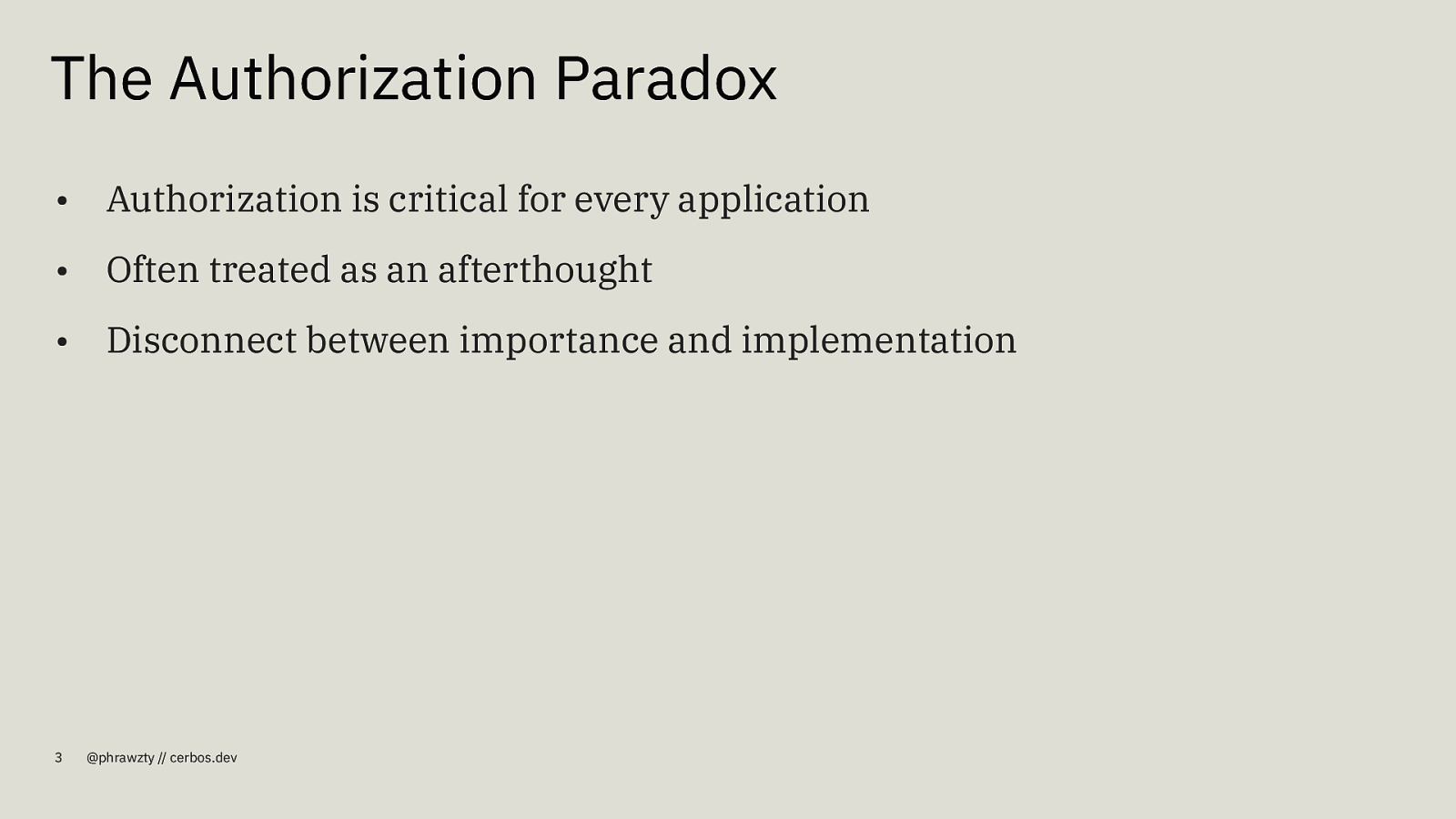
The Authorization Paradox • Authorization is critical for every application • Often treated as an afterthought • Disconnect between importance and implementation 3 @phrawzty // cerbos.dev
Slide 4
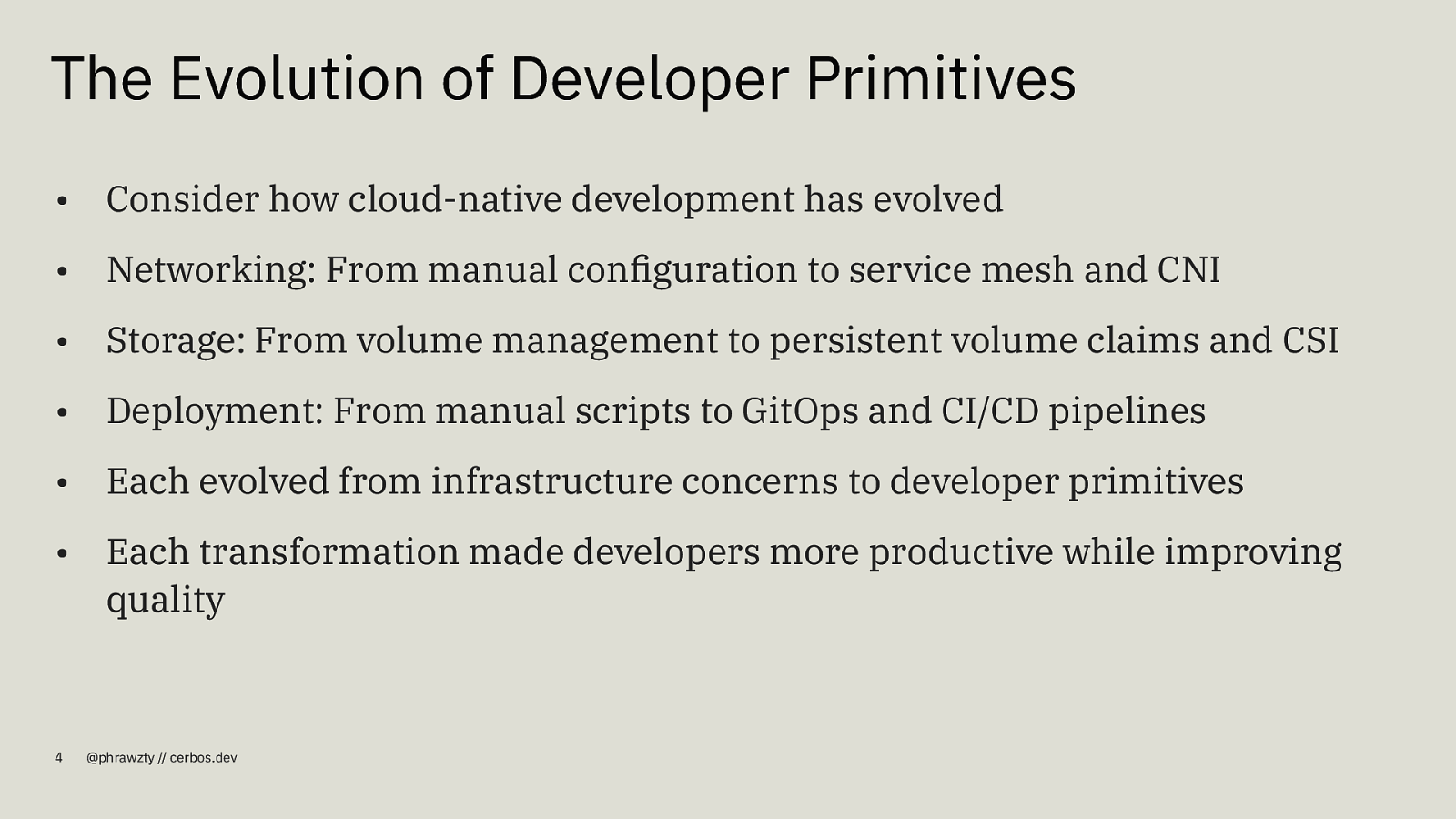
The Evolution of Developer Primitives • Consider how cloud-native development has evolved • Networking: From manual configuration to service mesh and CNI • Storage: From volume management to persistent volume claims and CSI • Deployment: From manual scripts to GitOps and CI/CD pipelines • Each evolved from infrastructure concerns to developer primitives • Each transformation made developers more productive while improving quality 4 @phrawzty // cerbos.dev
Slide 5
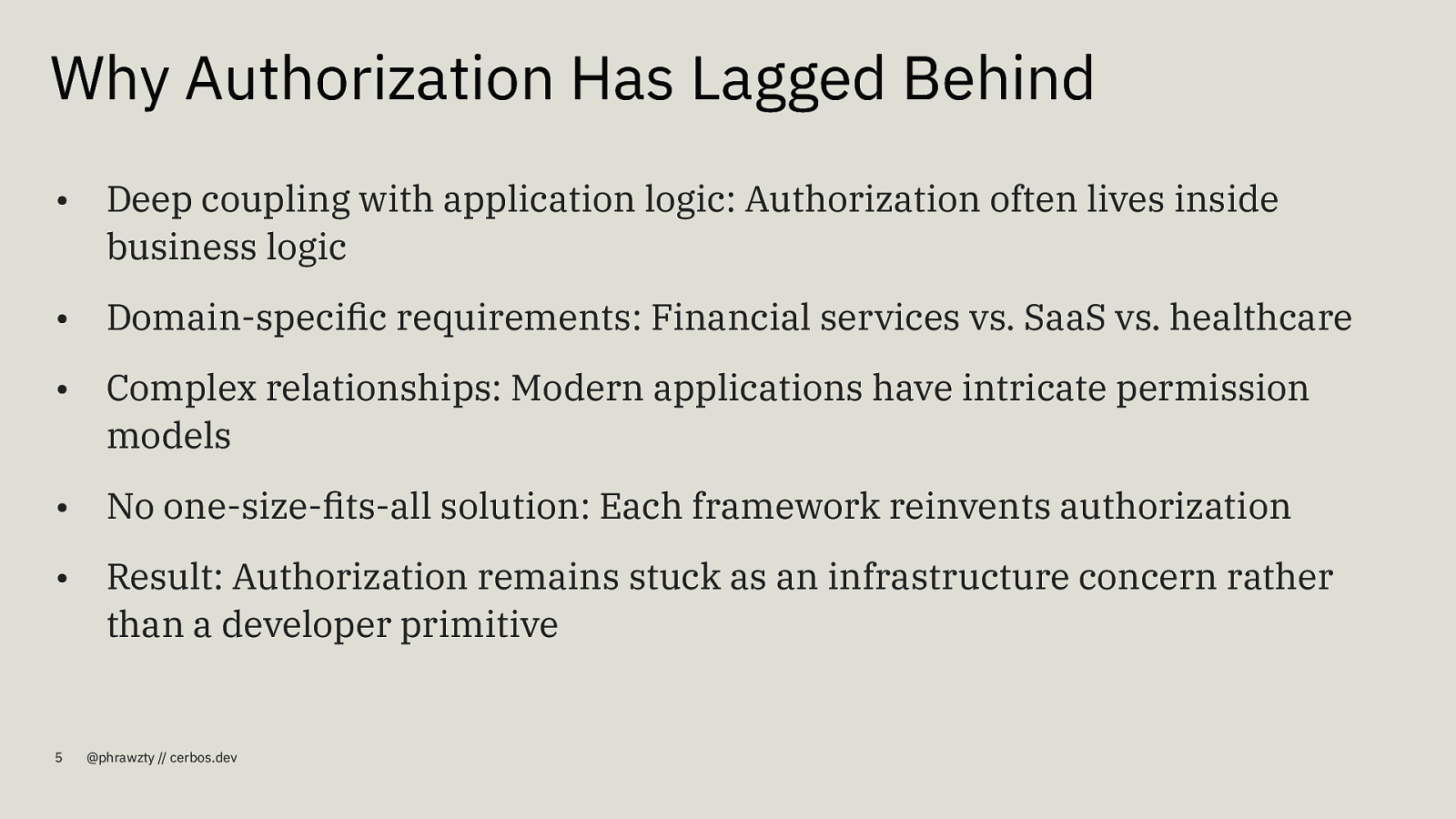
Why Authorization Has Lagged Behind • Deep coupling with application logic: Authorization often lives inside business logic • Domain-specific requirements: Financial services vs. SaaS vs. healthcare • Complex relationships: Modern applications have intricate permission models • No one-size-fits-all solution: Each framework reinvents authorization • Result: Authorization remains stuck as an infrastructure concern rather than a developer primitive 5 @phrawzty // cerbos.dev
Slide 6
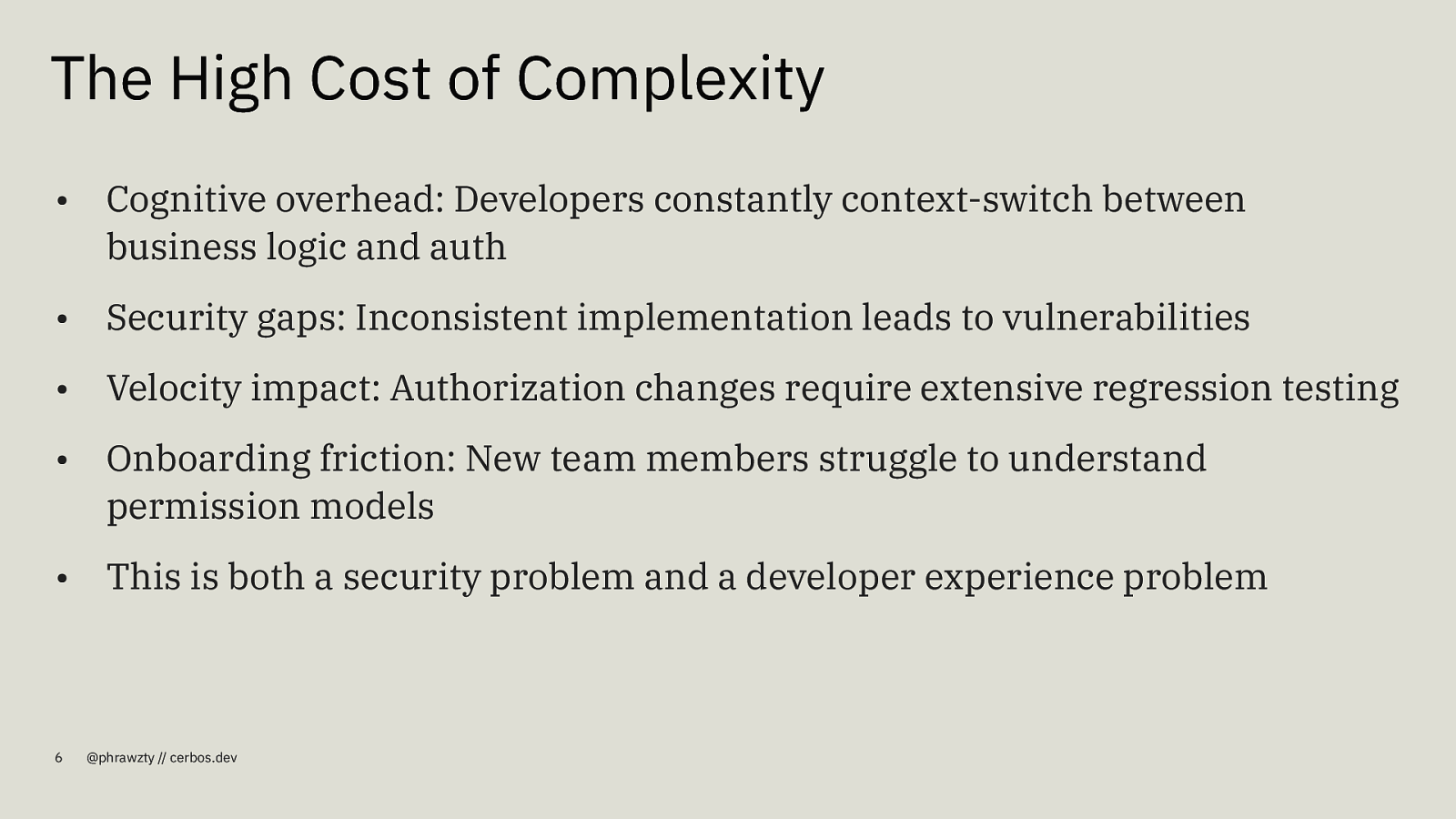
The High Cost of Complexity • Cognitive overhead: Developers constantly context-switch between business logic and auth • Security gaps: Inconsistent implementation leads to vulnerabilities • Velocity impact: Authorization changes require extensive regression testing • Onboarding friction: New team members struggle to understand permission models • This is both a security problem and a developer experience problem 6 @phrawzty // cerbos.dev
Slide 7
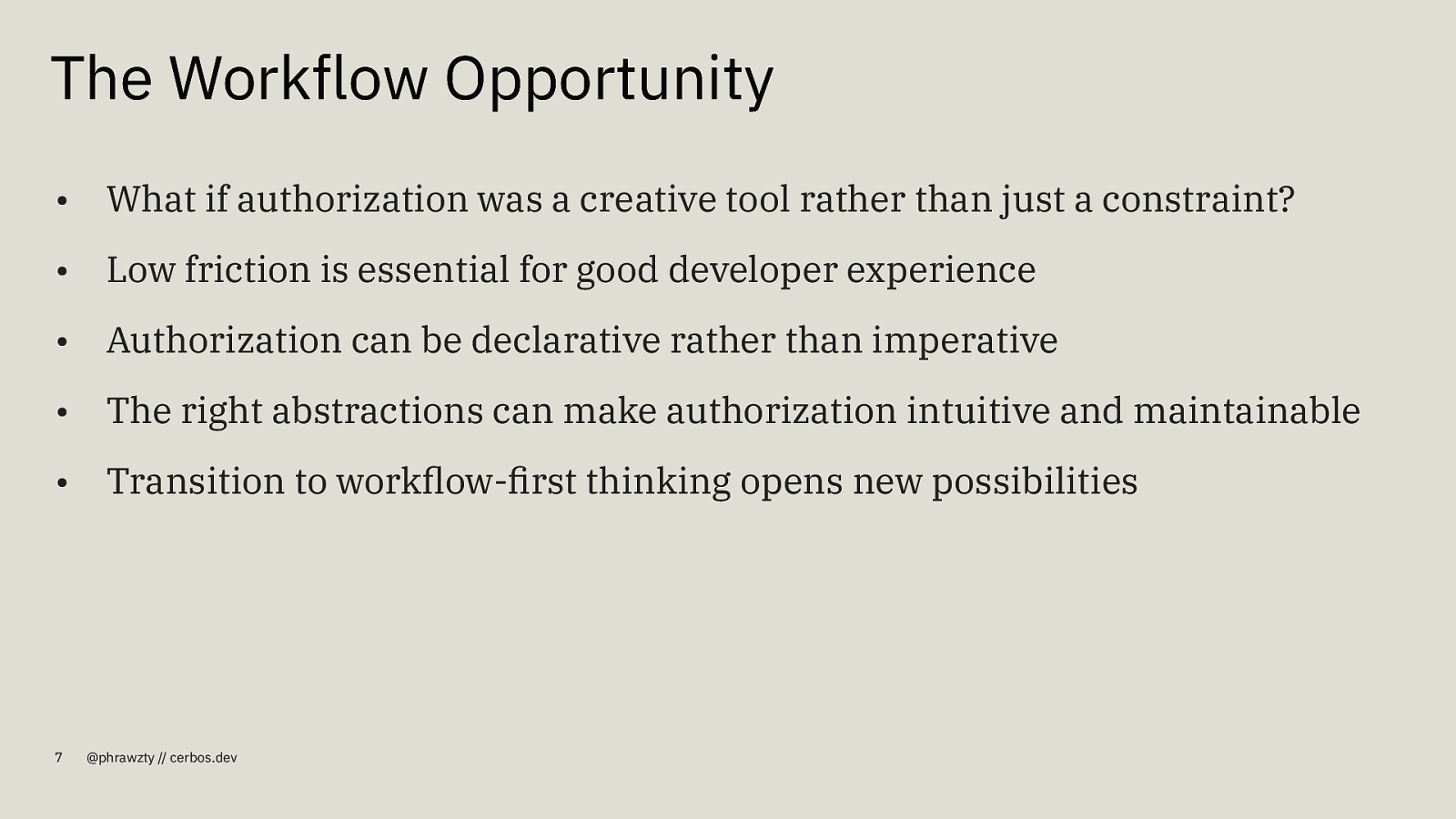
The Workflow Opportunity • What if authorization was a creative tool rather than just a constraint? • Low friction is essential for good developer experience • Authorization can be declarative rather than imperative • The right abstractions can make authorization intuitive and maintainable • Transition to workflow-first thinking opens new possibilities 7 @phrawzty // cerbos.dev
Slide 8
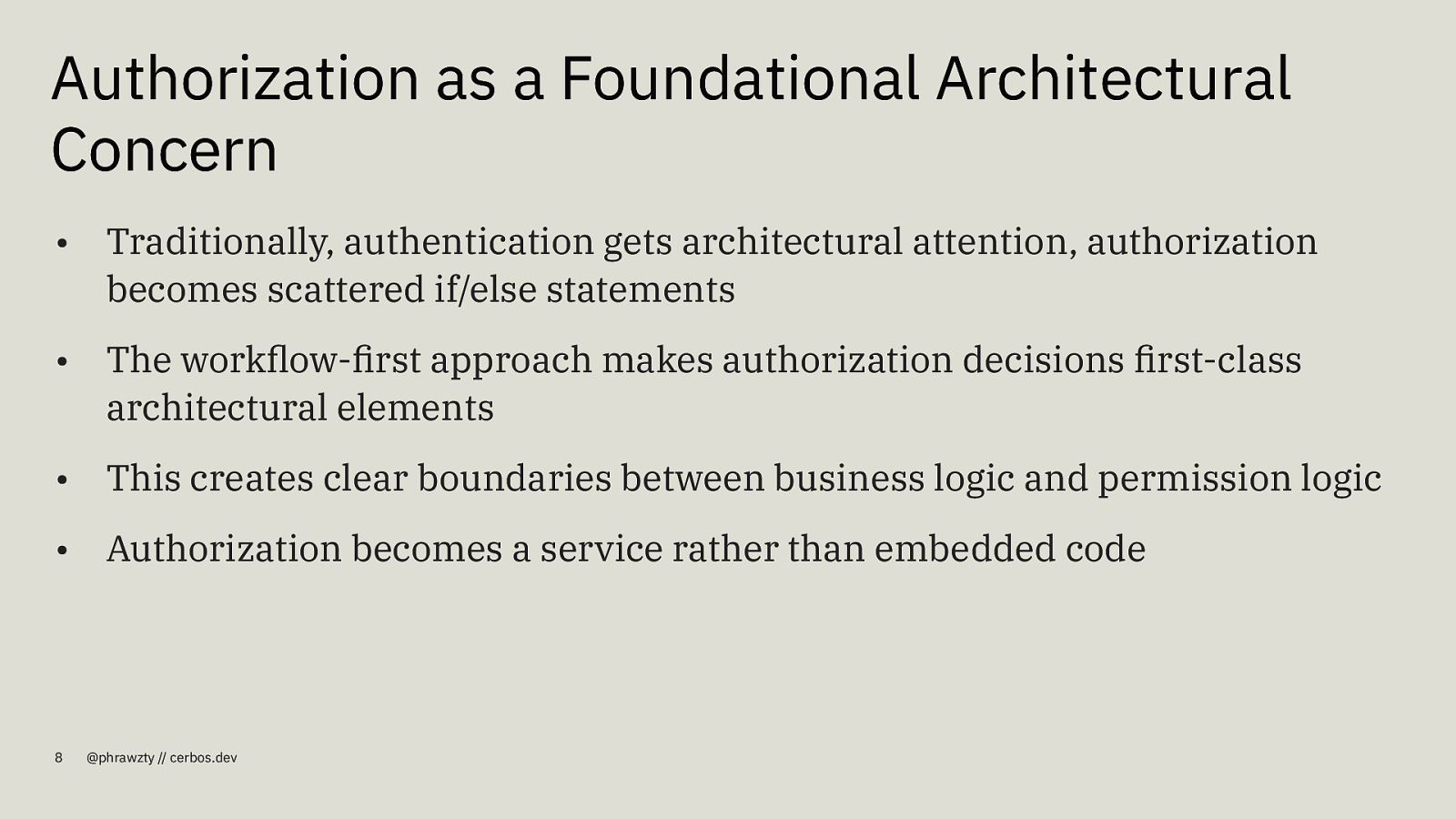
Authorization as a Foundational Architectural Concern • Traditionally, authentication gets architectural attention, authorization becomes scattered if/else statements • The workflow-first approach makes authorization decisions first-class architectural elements • This creates clear boundaries between business logic and permission logic • Authorization becomes a service rather than embedded code 8 @phrawzty // cerbos.dev
Slide 9
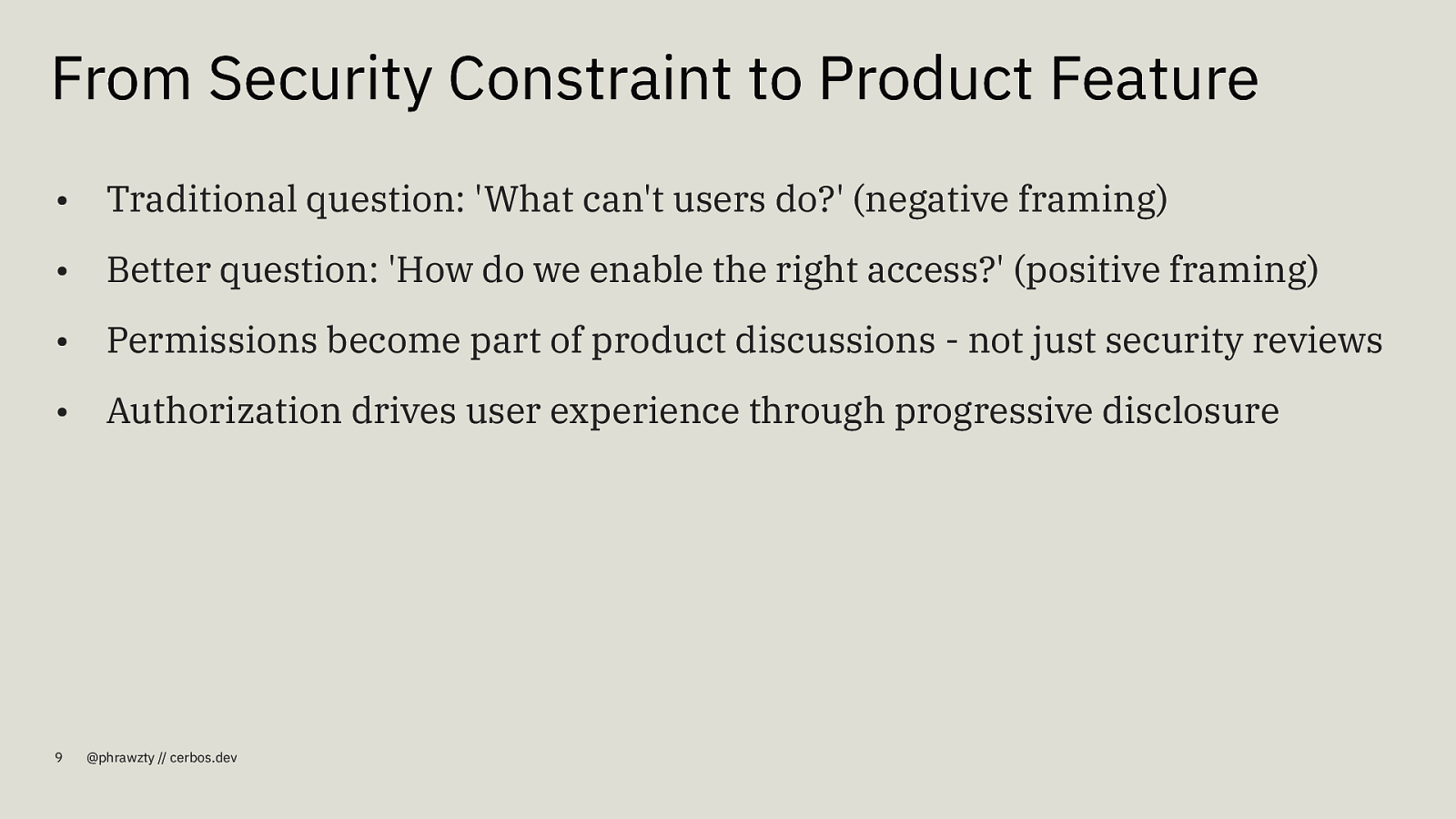
From Security Constraint to Product Feature • Traditional question: ‘What can’t users do?’ (negative framing) • Better question: ‘How do we enable the right access?’ (positive framing) • Permissions become part of product discussions - not just security reviews • Authorization drives user experience through progressive disclosure 9 @phrawzty // cerbos.dev
Slide 10
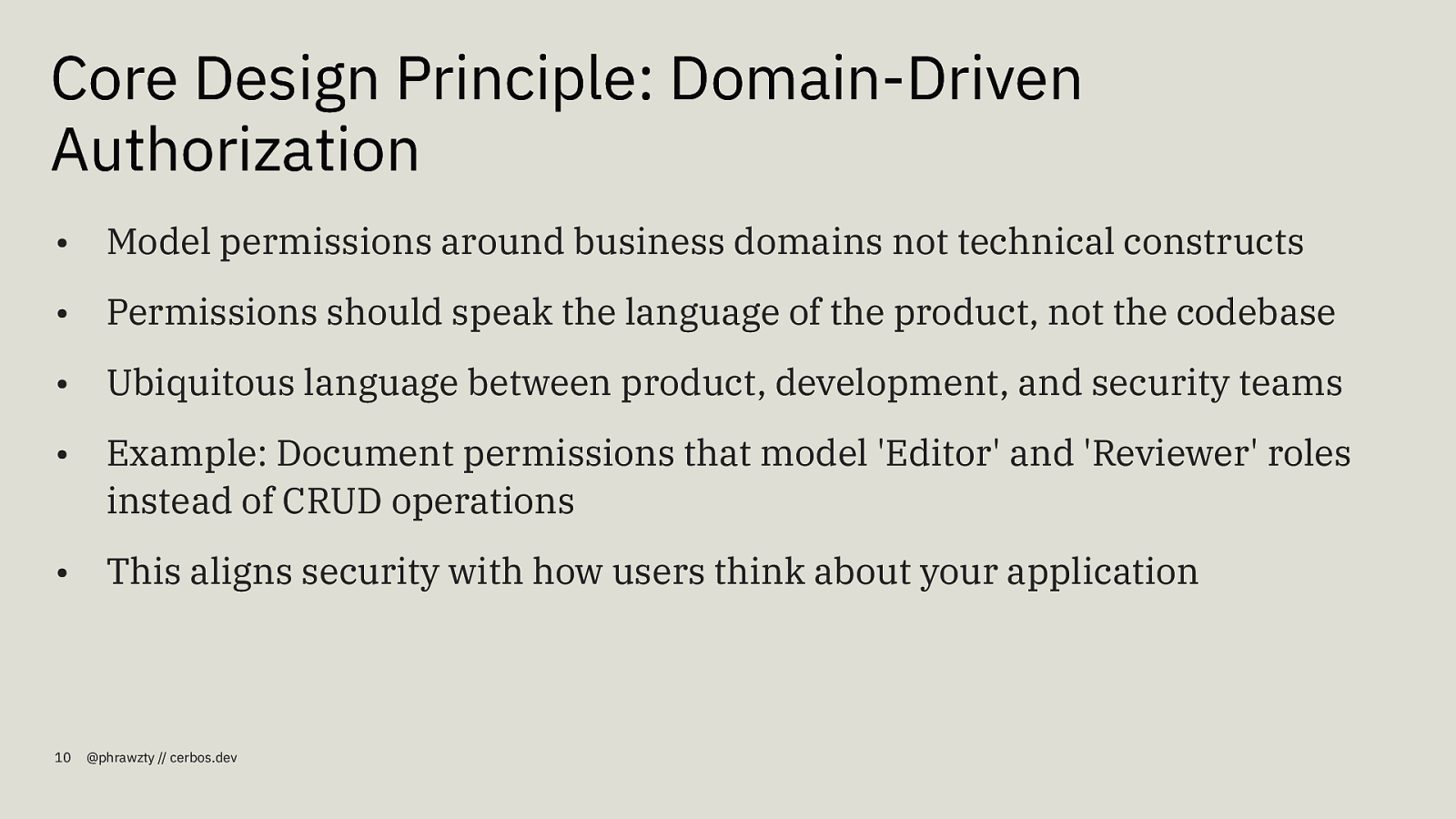
Core Design Principle: Domain-Driven Authorization • Model permissions around business domains not technical constructs • Permissions should speak the language of the product, not the codebase • Ubiquitous language between product, development, and security teams • Example: Document permissions that model ‘Editor’ and ‘Reviewer’ roles instead of CRUD operations • This aligns security with how users think about your application 10 @phrawzty // cerbos.dev
Slide 11
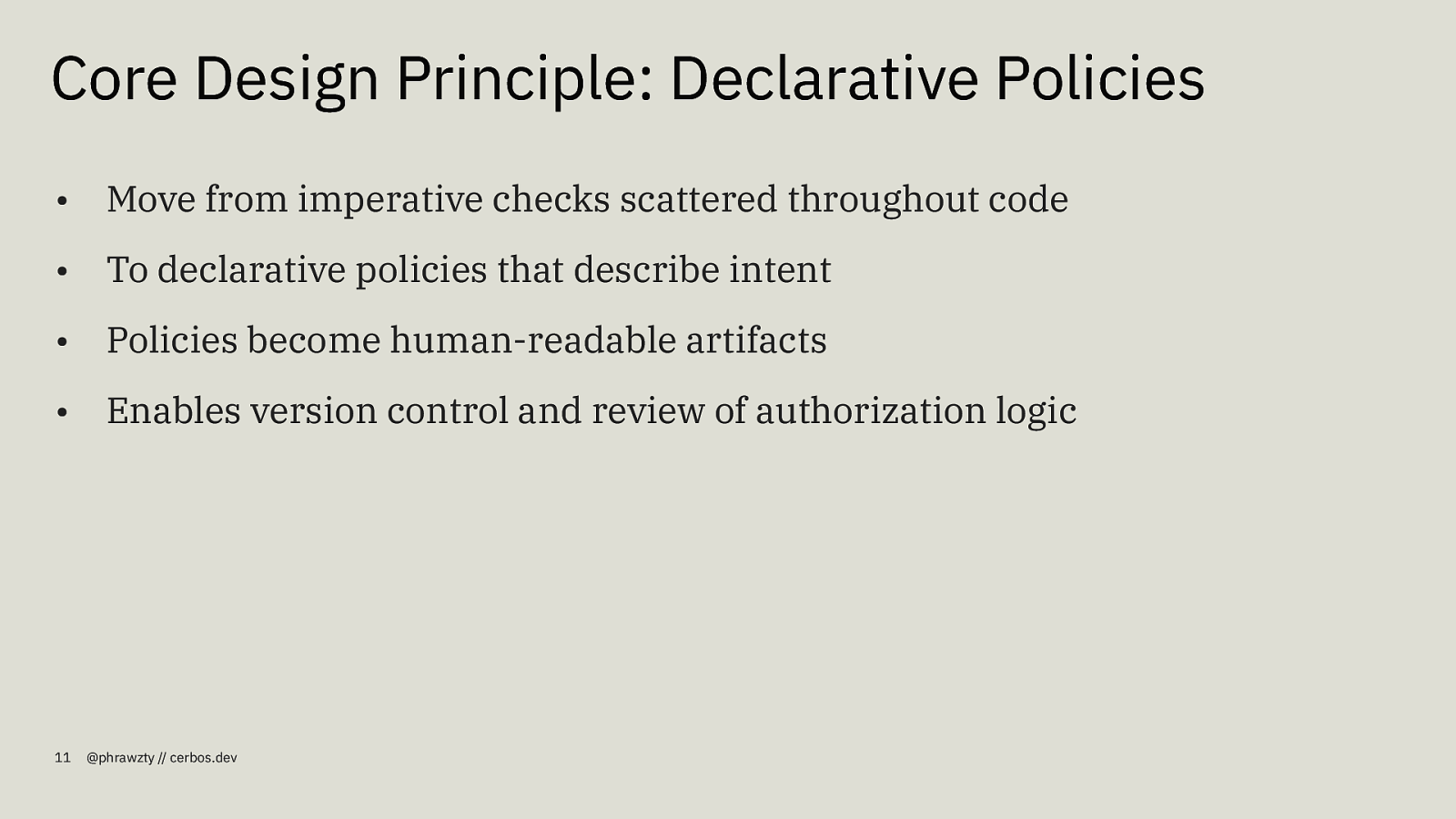
Core Design Principle: Declarative Policies • Move from imperative checks scattered throughout code • To declarative policies that describe intent • Policies become human-readable artifacts • Enables version control and review of authorization logic 11 @phrawzty // cerbos.dev
Slide 12
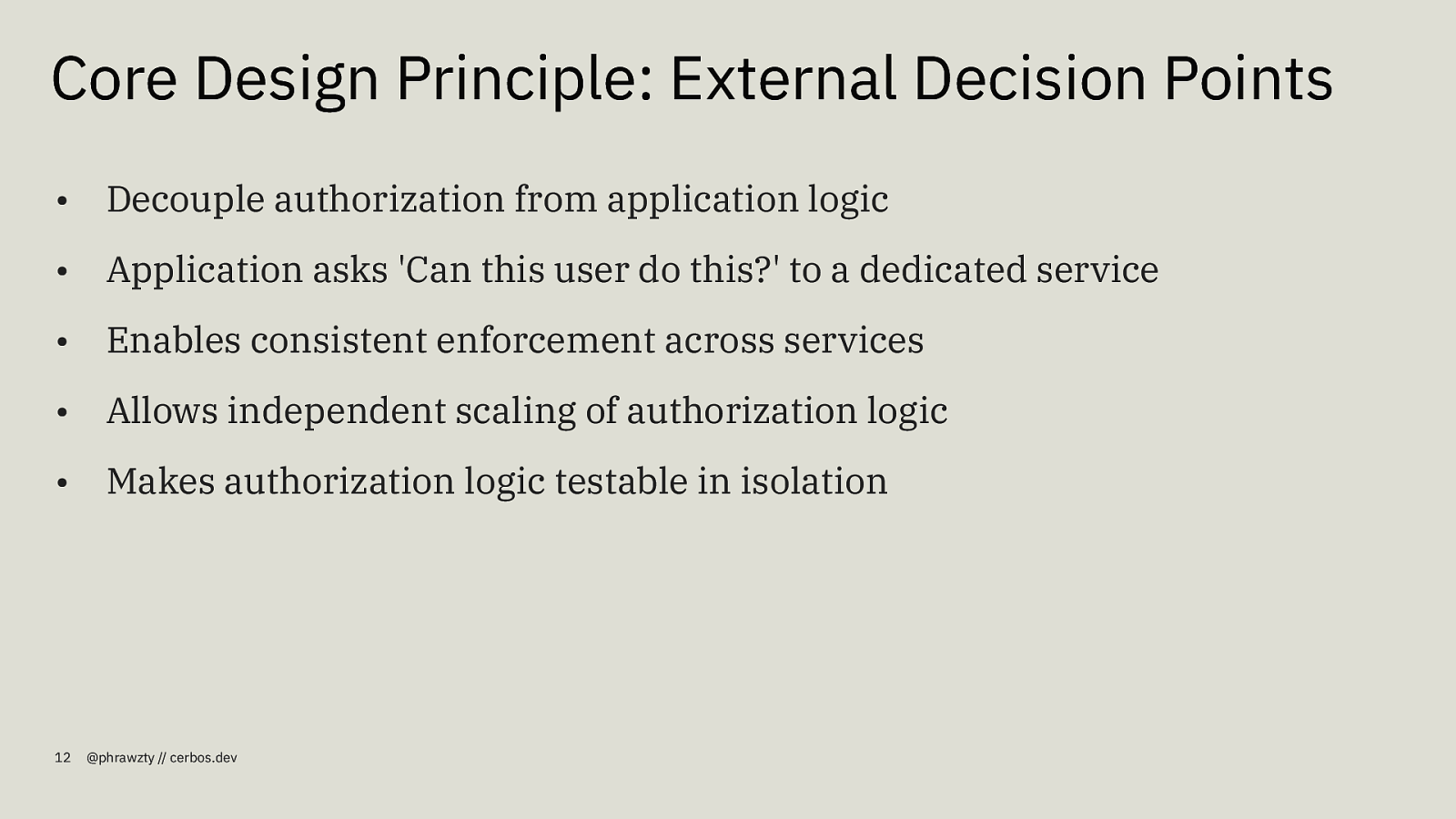
Core Design Principle: External Decision Points • Decouple authorization from application logic • Application asks ‘Can this user do this?’ to a dedicated service • Enables consistent enforcement across services • Allows independent scaling of authorization logic • Makes authorization logic testable in isolation 12 @phrawzty // cerbos.dev
Slide 13
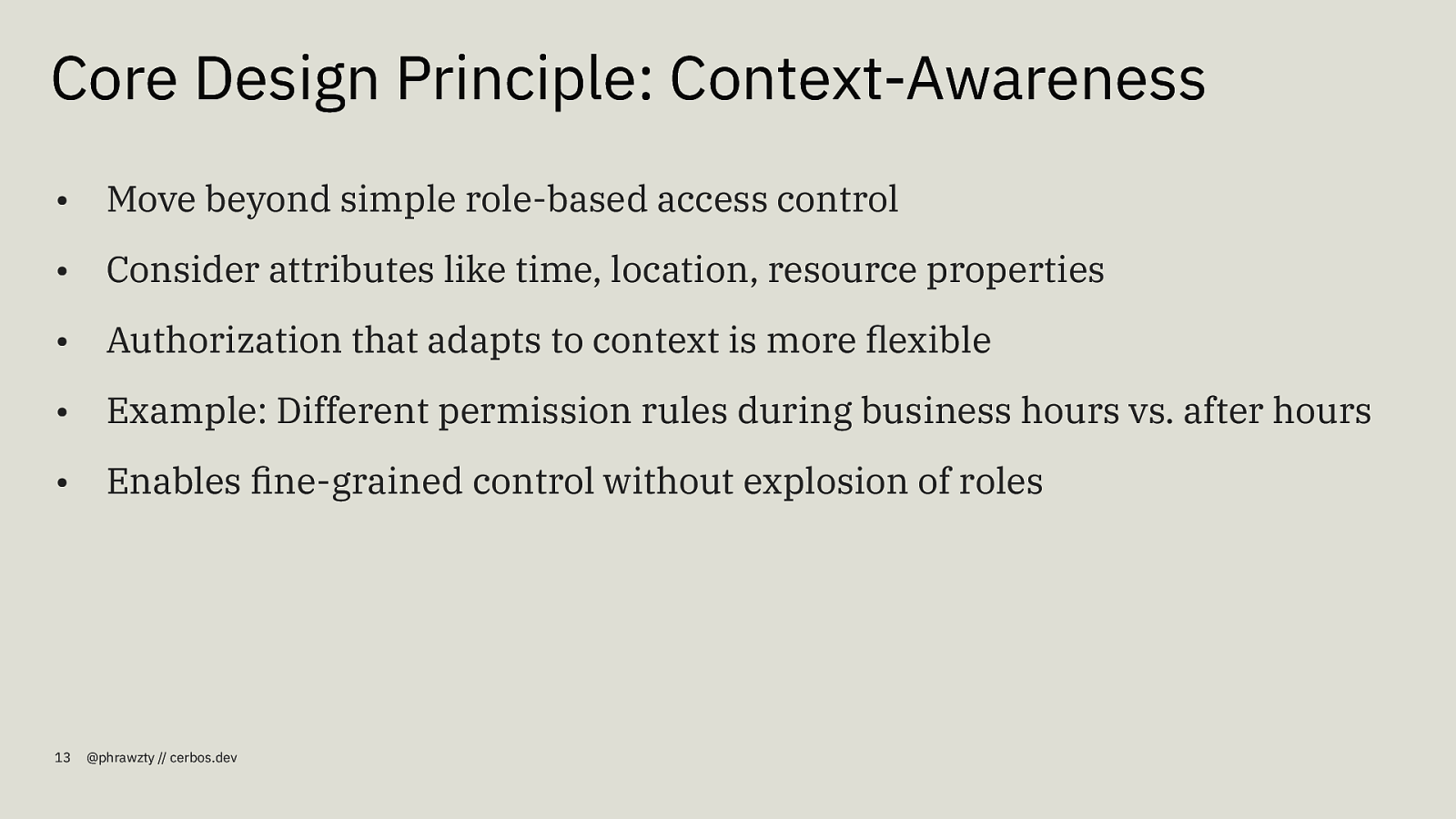
Core Design Principle: Context-Awareness • Move beyond simple role-based access control • Consider attributes like time, location, resource properties • Authorization that adapts to context is more flexible • Example: Different permission rules during business hours vs. after hours • Enables fine-grained control without explosion of roles 13 @phrawzty // cerbos.dev
Slide 14
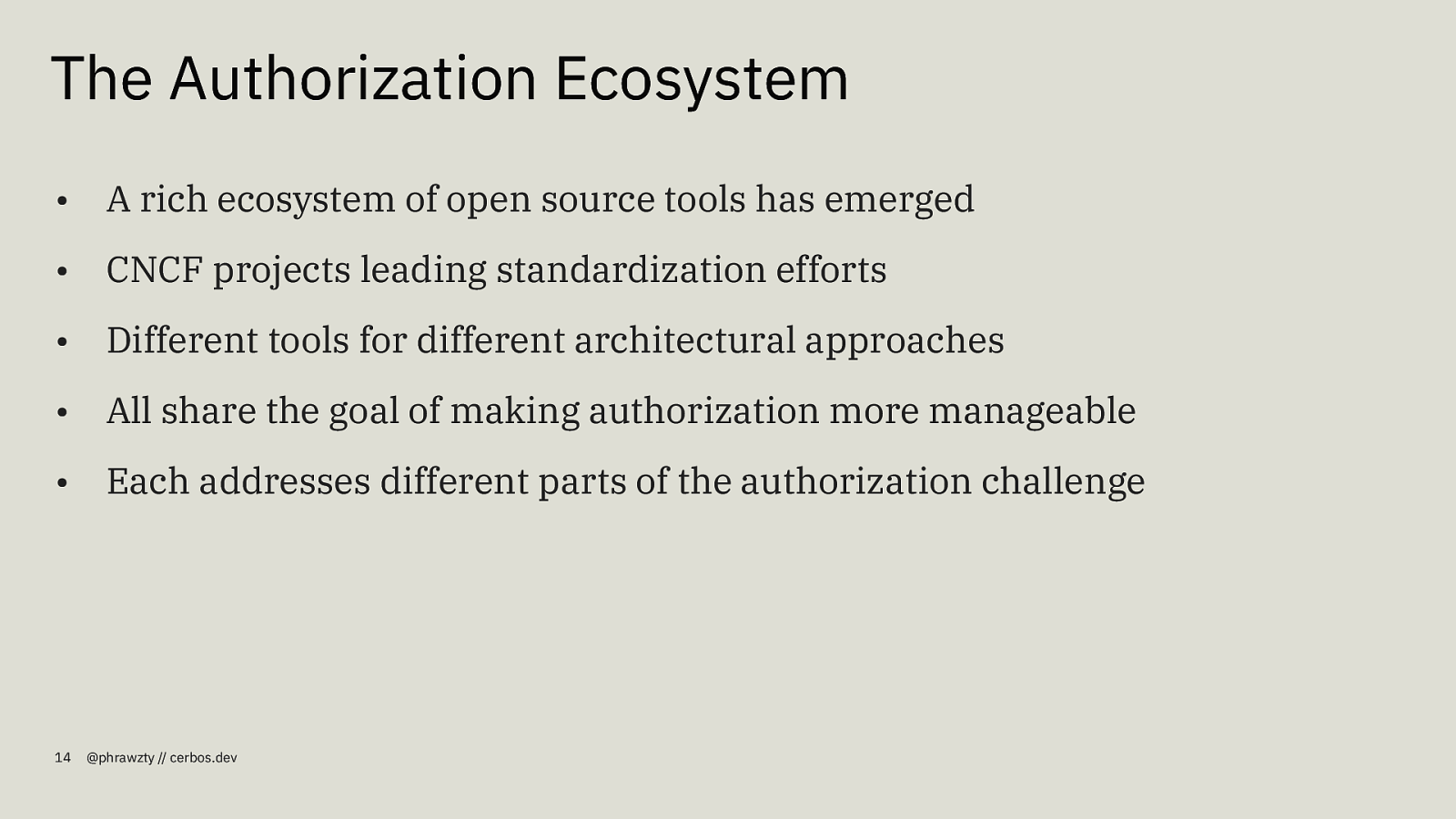
The Authorization Ecosystem • A rich ecosystem of open source tools has emerged • CNCF projects leading standardization efforts • Different tools for different architectural approaches • All share the goal of making authorization more manageable • Each addresses different parts of the authorization challenge 14 @phrawzty // cerbos.dev
Slide 15
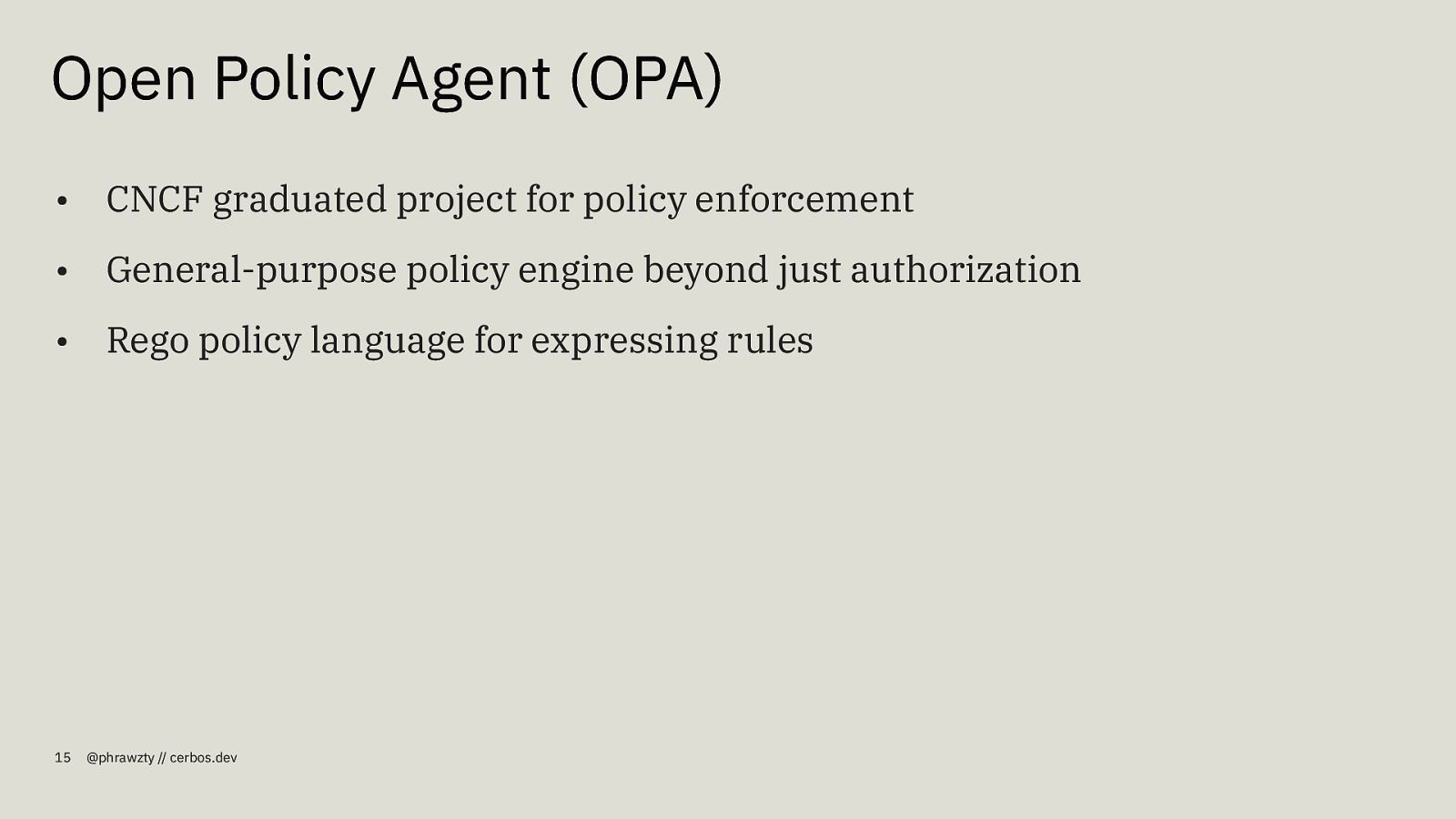
Open Policy Agent (OPA) • CNCF graduated project for policy enforcement • General-purpose policy engine beyond just authorization • Rego policy language for expressing rules 15 @phrawzty // cerbos.dev
Slide 16
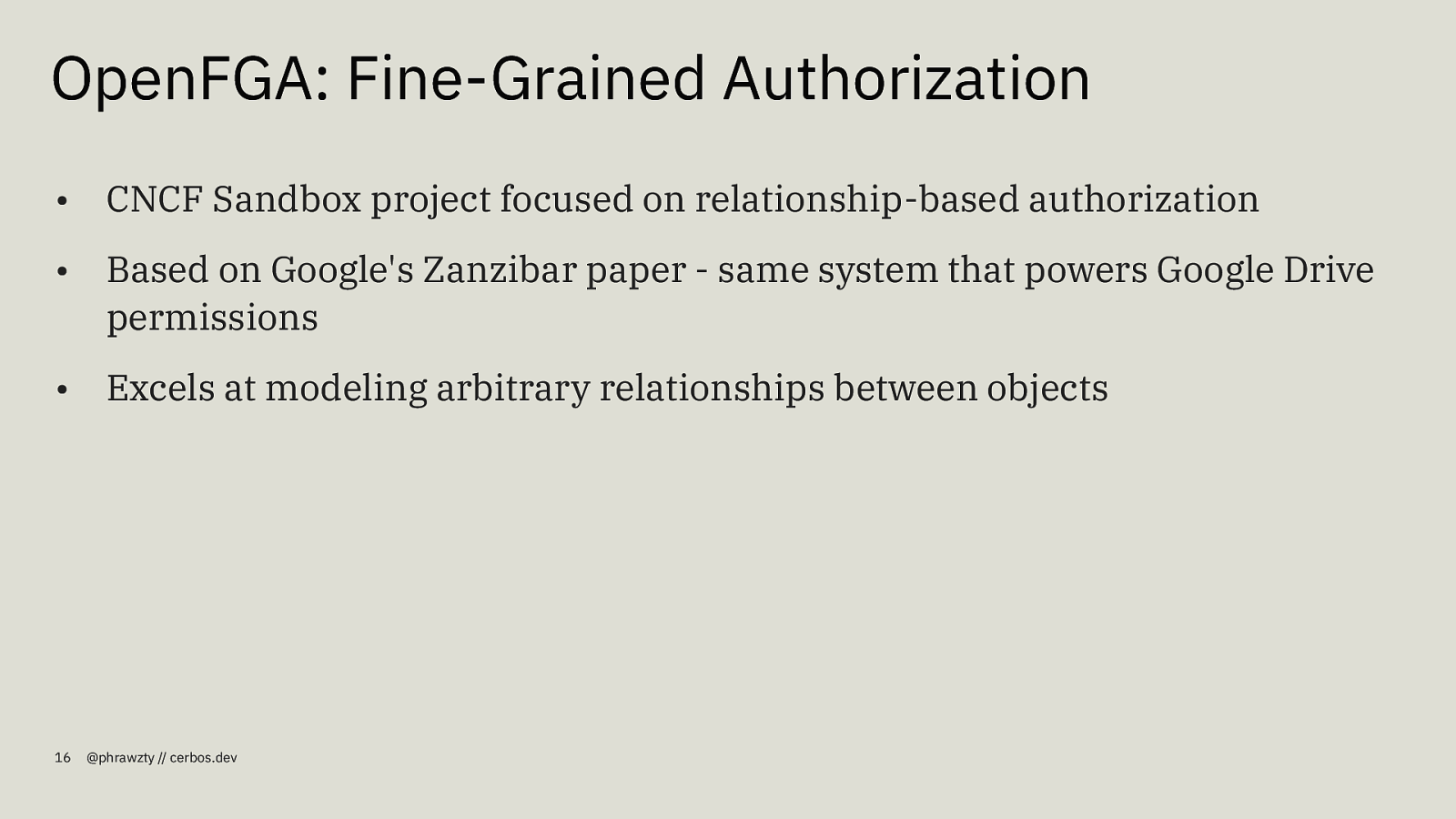
OpenFGA: Fine-Grained Authorization • CNCF Sandbox project focused on relationship-based authorization • Based on Google’s Zanzibar paper - same system that powers Google Drive permissions • Excels at modeling arbitrary relationships between objects 16 @phrawzty // cerbos.dev
Slide 17
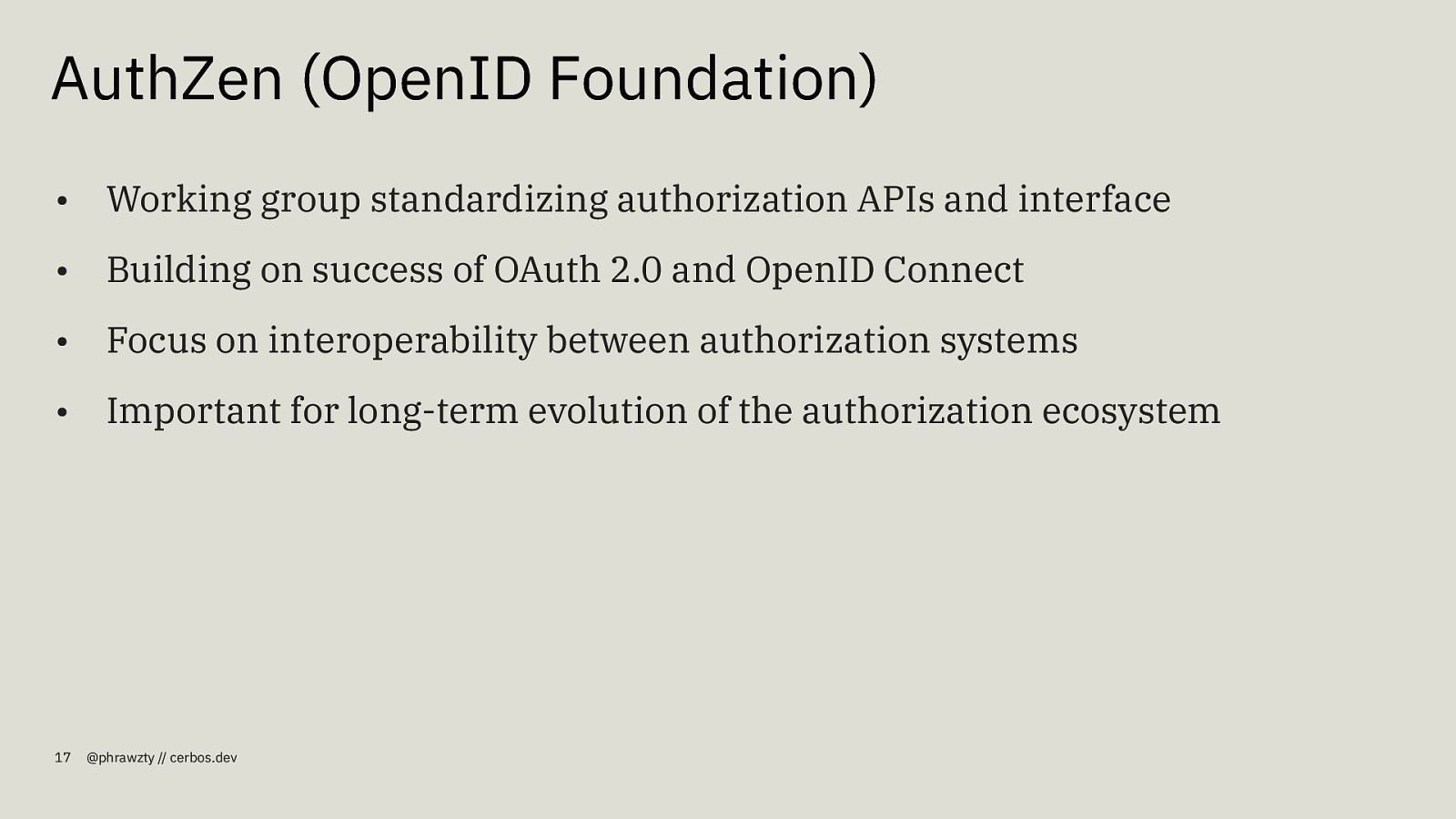
AuthZen (OpenID Foundation) • Working group standardizing authorization APIs and interface • Building on success of OAuth 2.0 and OpenID Connect • Focus on interoperability between authorization systems • Important for long-term evolution of the authorization ecosystem 17 @phrawzty // cerbos.dev
Slide 18

Cerbos: Developer-Centric Authorization • Human-readable YAML policies that product teams can understand • IDE integrations for real-time policy validation • Designed for frictionless developer workflows • Particularly strong for testing and debugging authorization logic 18 @phrawzty // cerbos.dev
Slide 19

Choosing the Right Tool • No one-size-fits-all solution • Consider your architecture and team structure • OPA: Broad policy enforcement beyond just authorization • OpenFGA: Complex relationship-based permissions at scale • Cerbos: Developer workflow integration and simplicity • Many teams use multiple tools for different aspects 19 @phrawzty // cerbos.dev
Slide 20
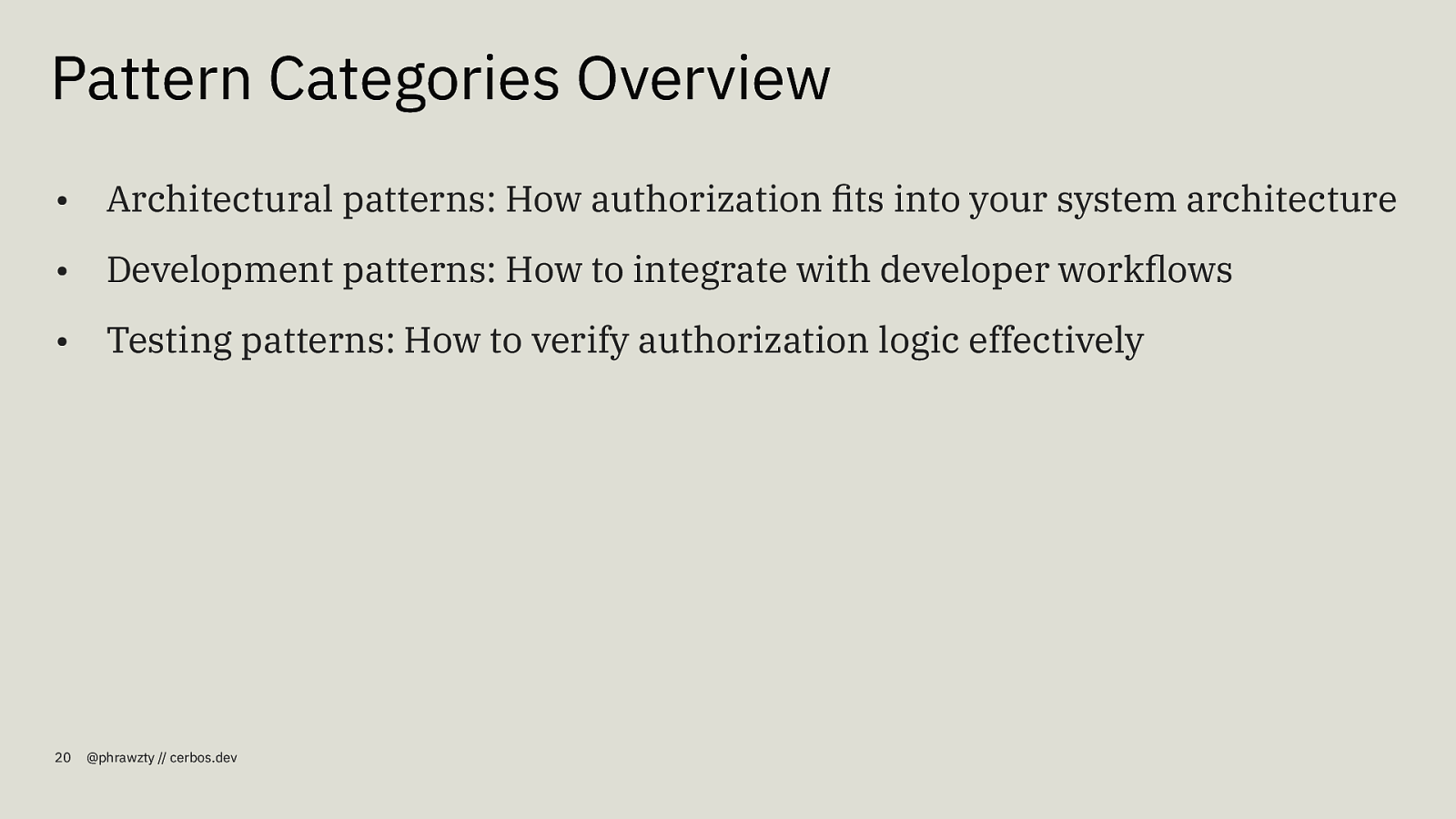
Pattern Categories Overview • Architectural patterns: How authorization fits into your system architecture • Development patterns: How to integrate with developer workflows • Testing patterns: How to verify authorization logic effectively 20 @phrawzty // cerbos.dev
Slide 21
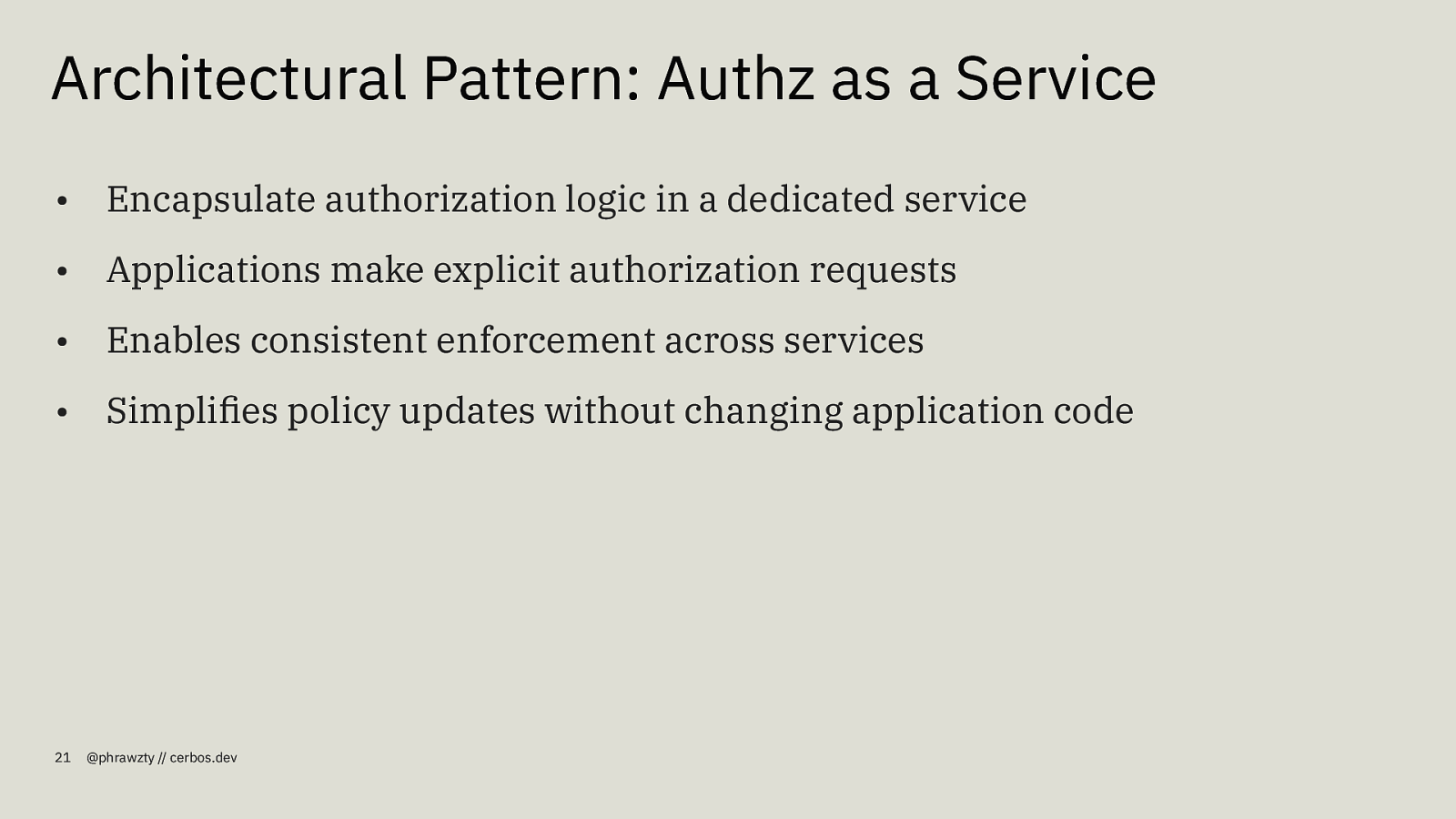
Architectural Pattern: Authz as a Service • Encapsulate authorization logic in a dedicated service • Applications make explicit authorization requests • Enables consistent enforcement across services • Simplifies policy updates without changing application code 21 @phrawzty // cerbos.dev
Slide 22

Architectural Pattern: Sidecar Deployment • Deploy authorization engine alongside each service instance • Low latency for authorization decisions • No network hop for every decision • Maintains consistent policies via centralized distribution • Perfect for Kubernetes environments 22 @phrawzty // cerbos.dev
Slide 23
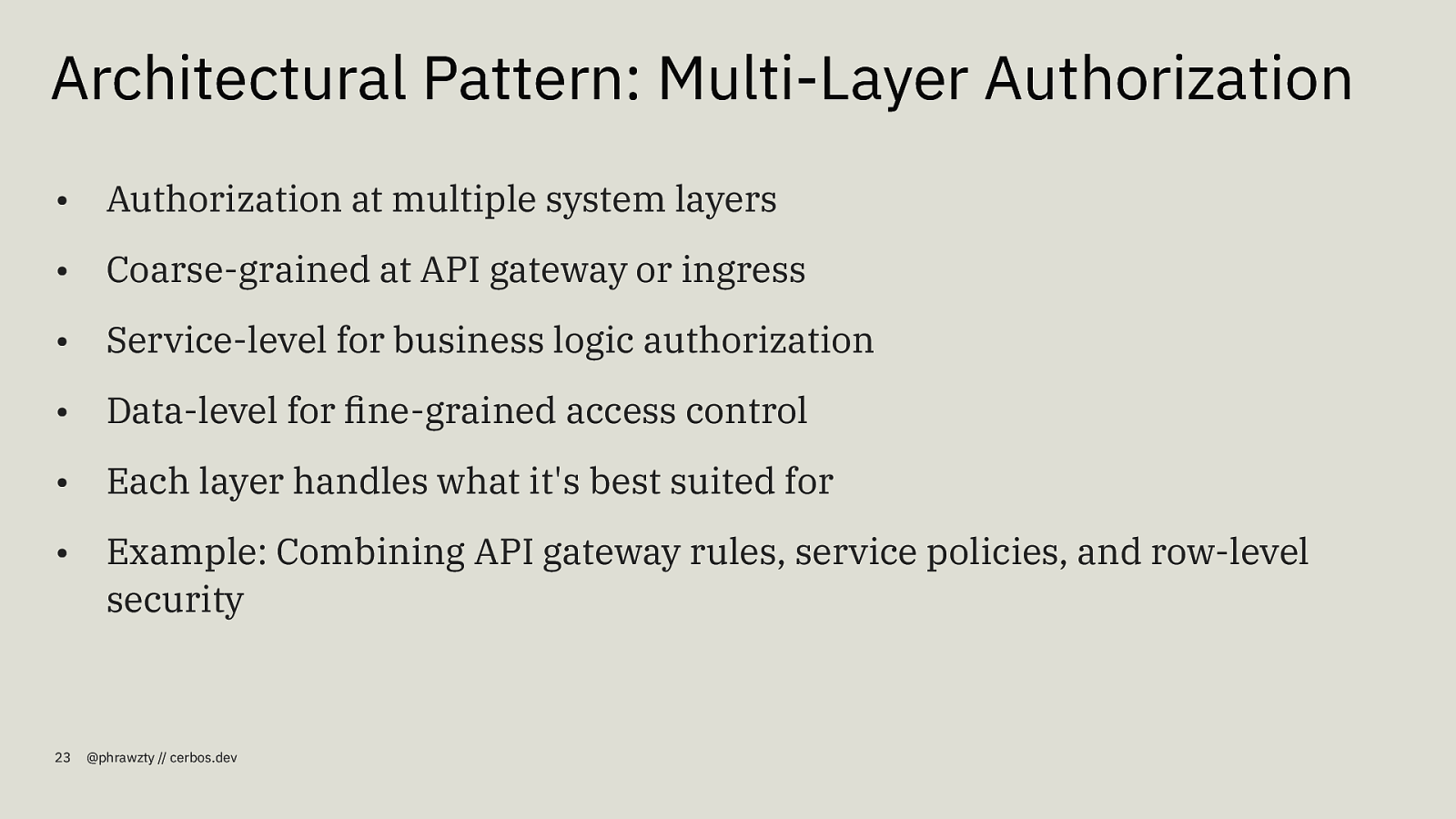
Architectural Pattern: Multi-Layer Authorization • Authorization at multiple system layers • Coarse-grained at API gateway or ingress • Service-level for business logic authorization • Data-level for fine-grained access control • Each layer handles what it’s best suited for • Example: Combining API gateway rules, service policies, and row-level security 23 @phrawzty // cerbos.dev
Slide 24
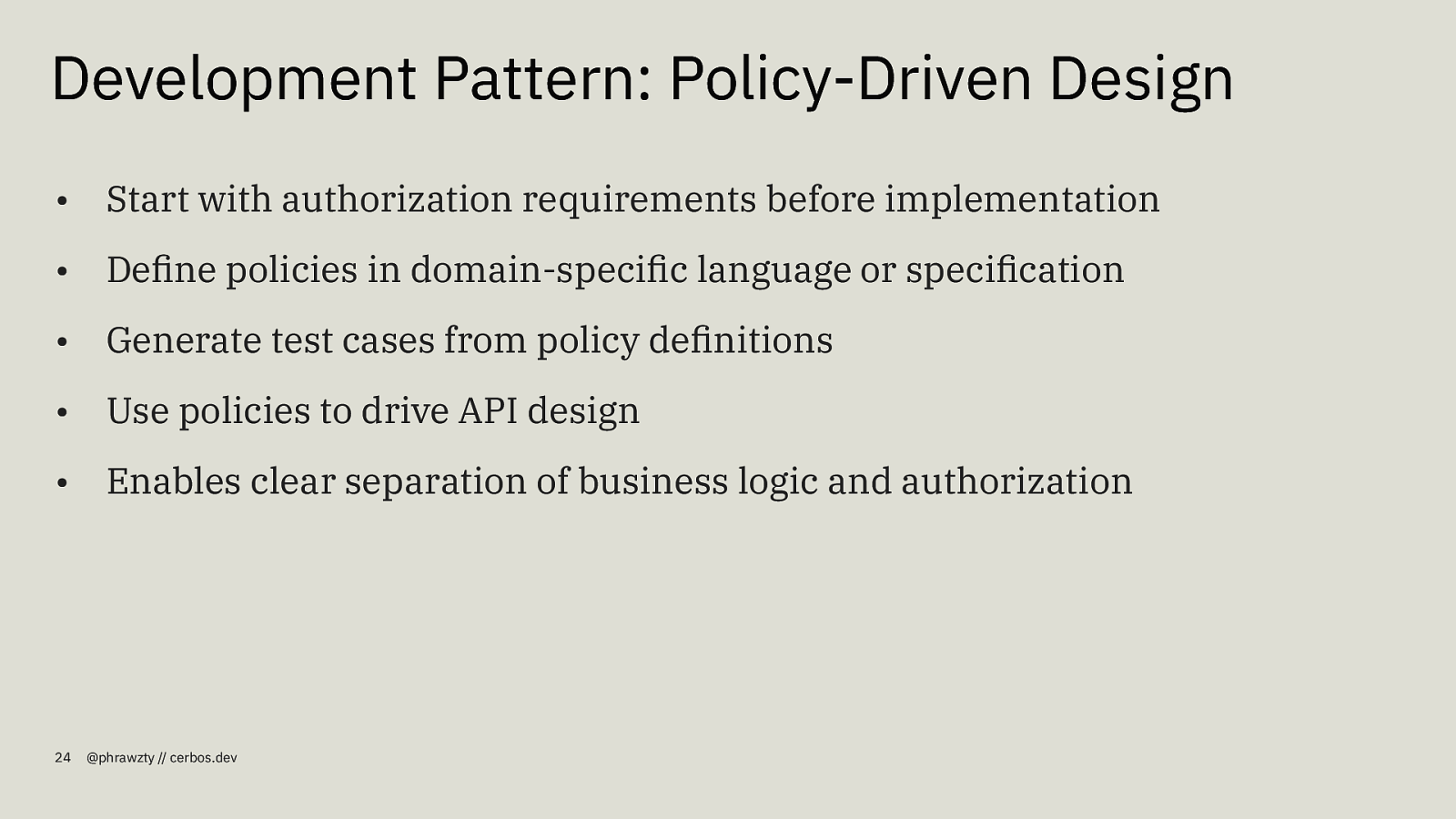
Development Pattern: Policy-Driven Design • Start with authorization requirements before implementation • Define policies in domain-specific language or specification • Generate test cases from policy definitions • Use policies to drive API design • Enables clear separation of business logic and authorization 24 @phrawzty // cerbos.dev
Slide 25
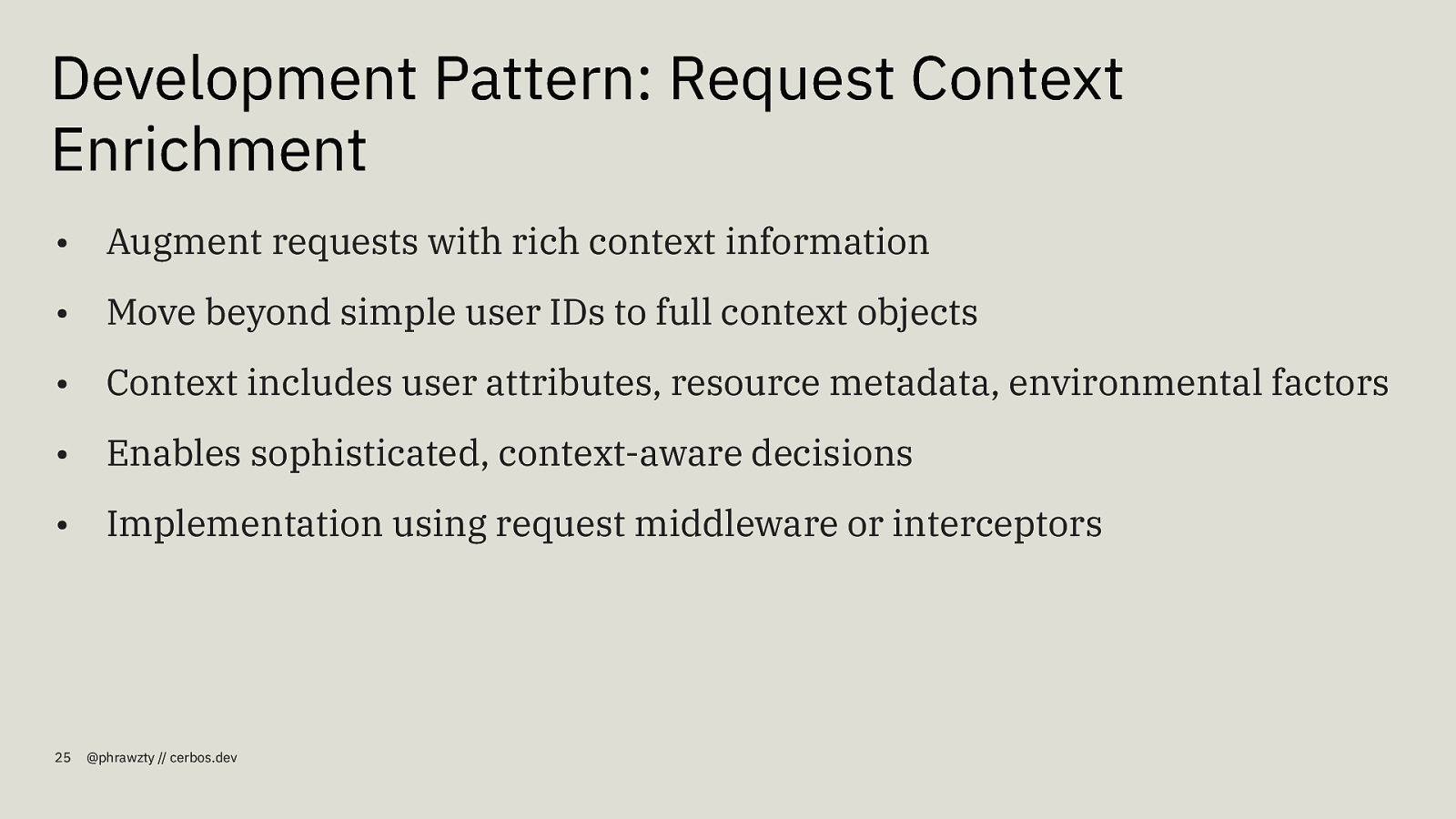
Development Pattern: Request Context Enrichment • Augment requests with rich context information • Move beyond simple user IDs to full context objects • Context includes user attributes, resource metadata, environmental factors • Enables sophisticated, context-aware decisions • Implementation using request middleware or interceptors 25 @phrawzty // cerbos.dev
Slide 26

Testing Pattern: Policy Unit Testing • Test policies independent of application code • Table-driven testing for multiple scenarios • Verify both allowed and denied cases • Test for edge cases and unusual conditions • Catch policy bugs before they reach production 26 @phrawzty // cerbos.dev
Slide 27
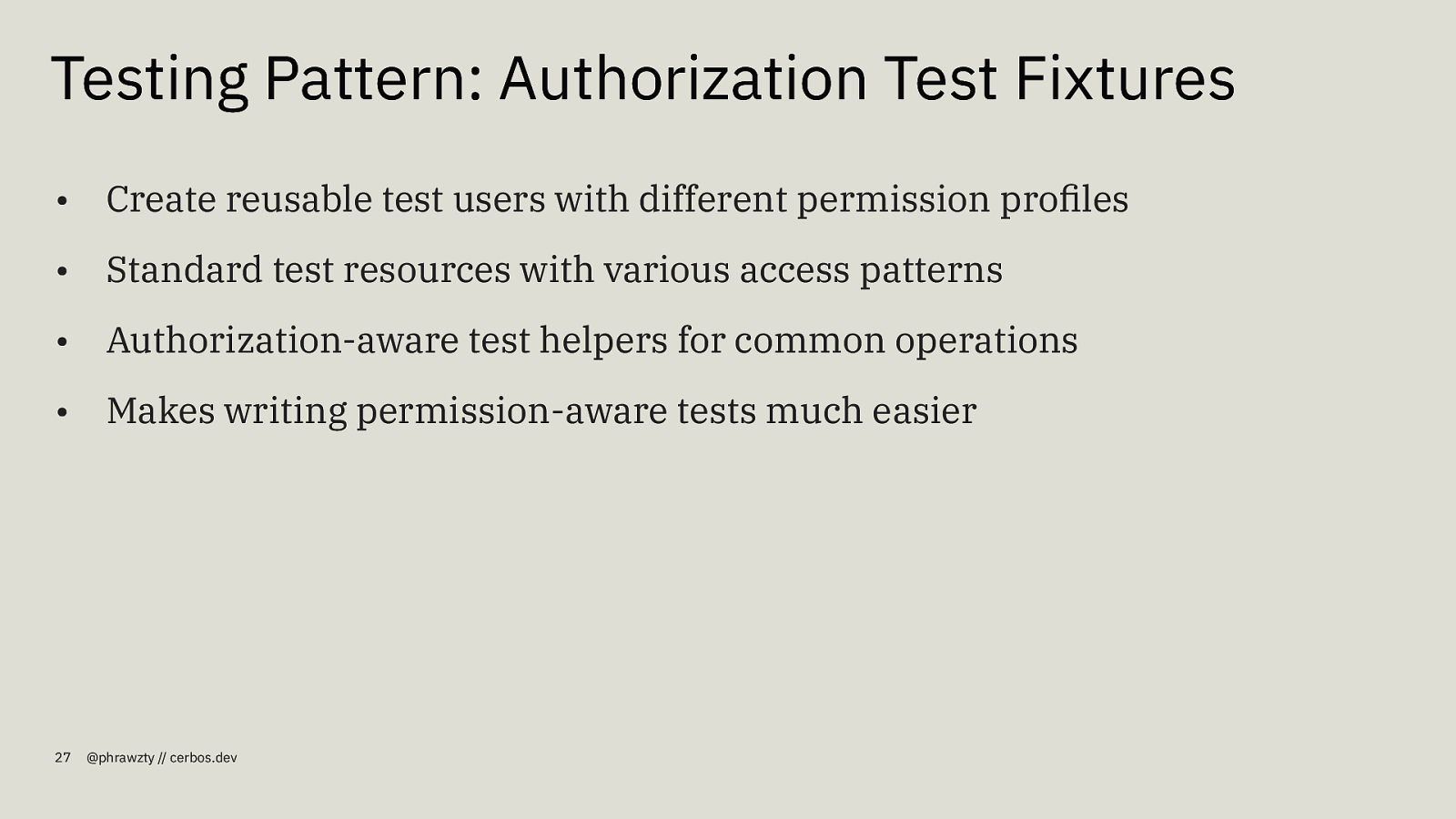
Testing Pattern: Authorization Test Fixtures • Create reusable test users with different permission profiles • Standard test resources with various access patterns • Authorization-aware test helpers for common operations • Makes writing permission-aware tests much easier 27 @phrawzty // cerbos.dev
Slide 28
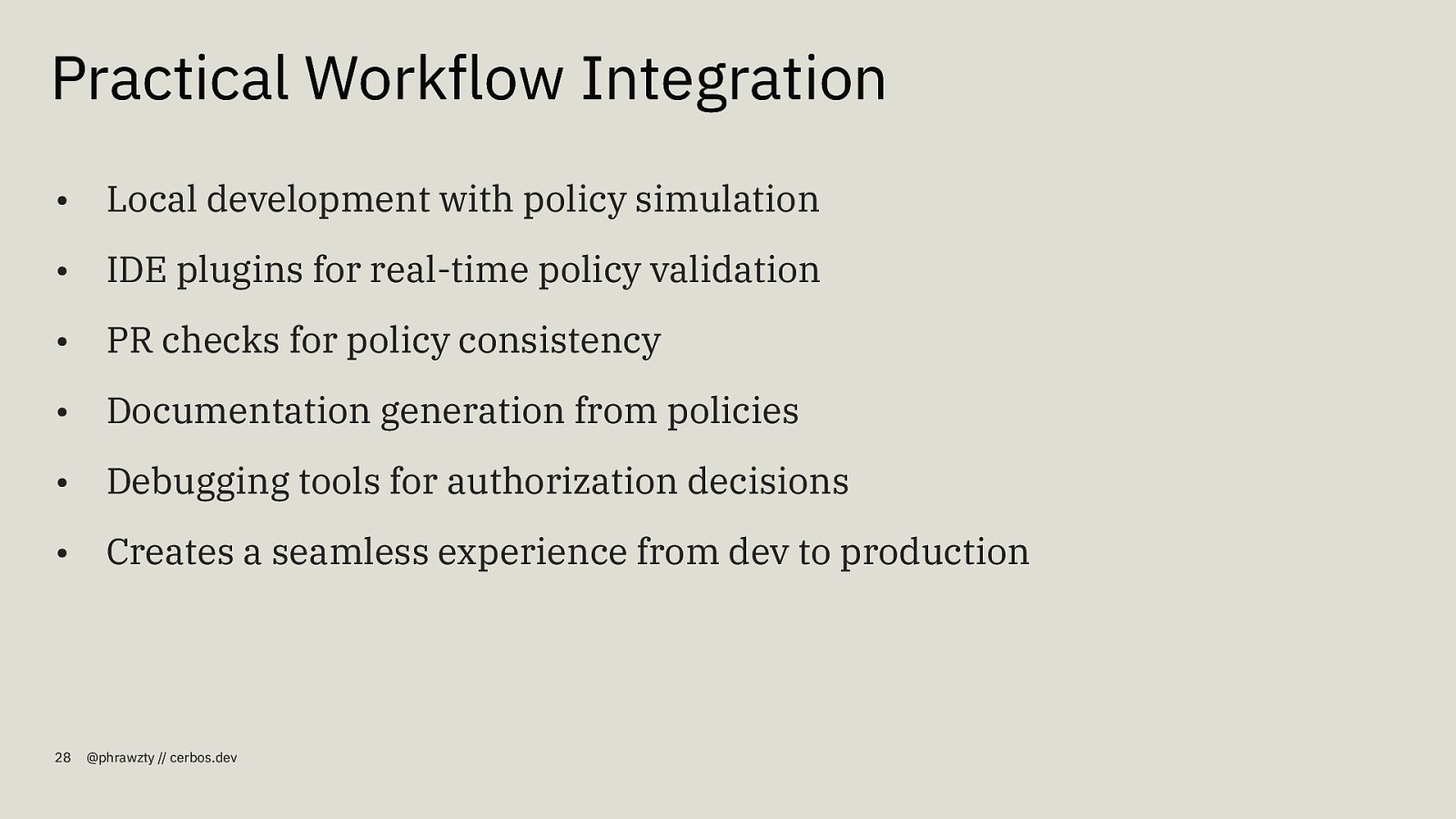
Practical Workflow Integration • Local development with policy simulation • IDE plugins for real-time policy validation • PR checks for policy consistency • Documentation generation from policies • Debugging tools for authorization decisions • Creates a seamless experience from dev to production 28 @phrawzty // cerbos.dev
Slide 29
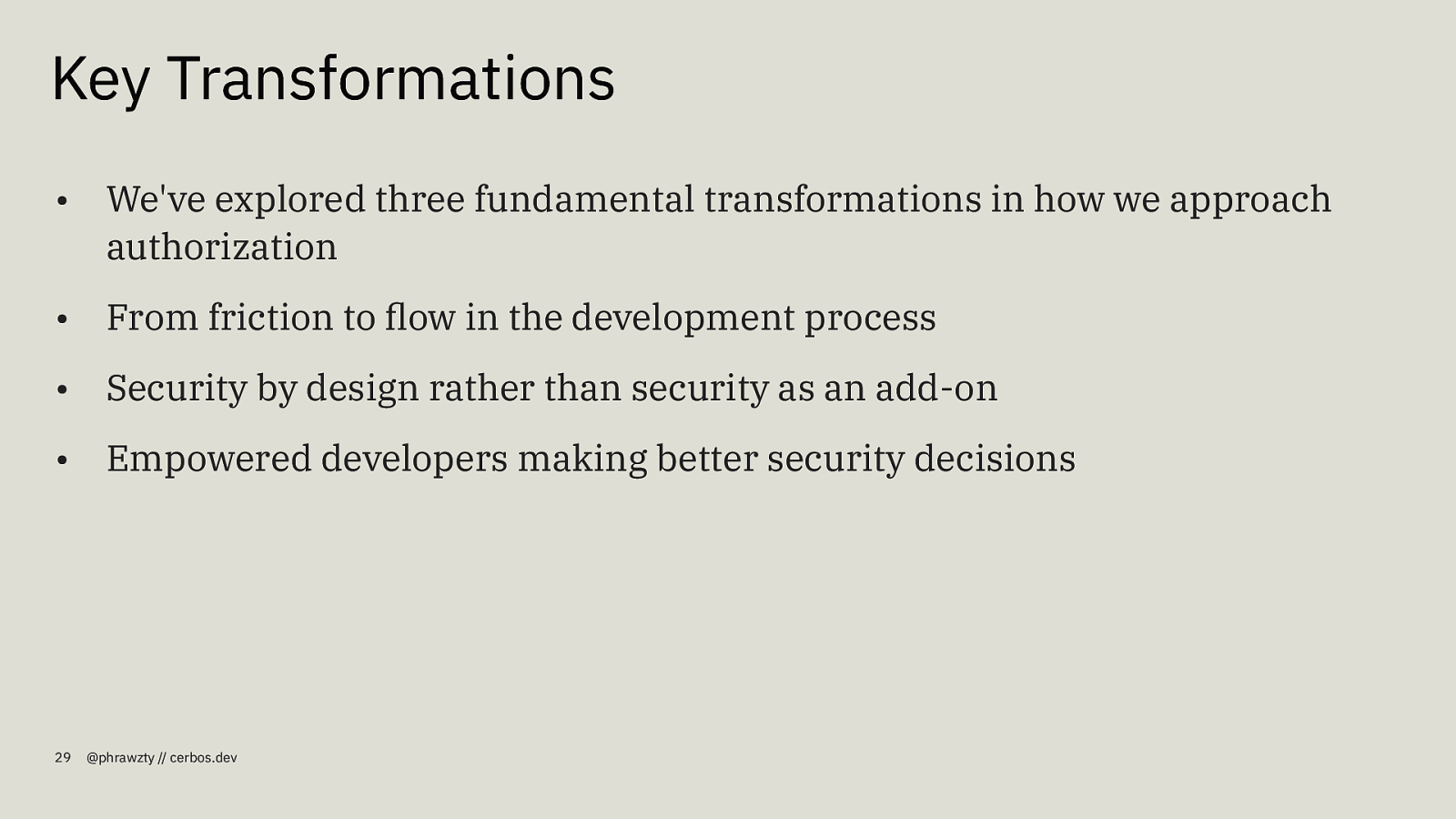
Key Transformations • We’ve explored three fundamental transformations in how we approach authorization • From friction to flow in the development process • Security by design rather than security as an add-on • Empowered developers making better security decisions 29 @phrawzty // cerbos.dev
Slide 30
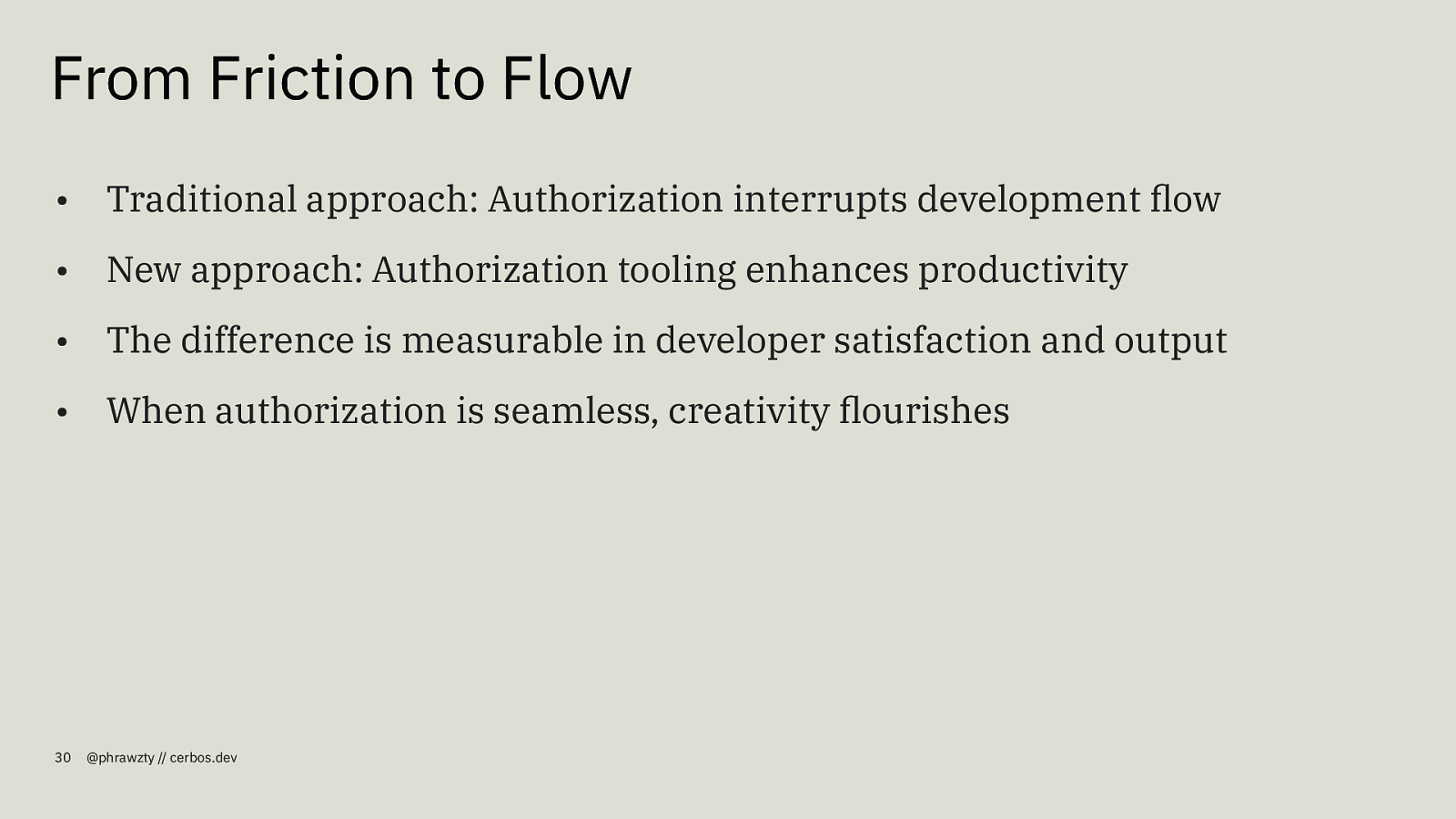
From Friction to Flow • Traditional approach: Authorization interrupts development flow • New approach: Authorization tooling enhances productivity • The difference is measurable in developer satisfaction and output • When authorization is seamless, creativity flourishes 30 @phrawzty // cerbos.dev
Slide 31
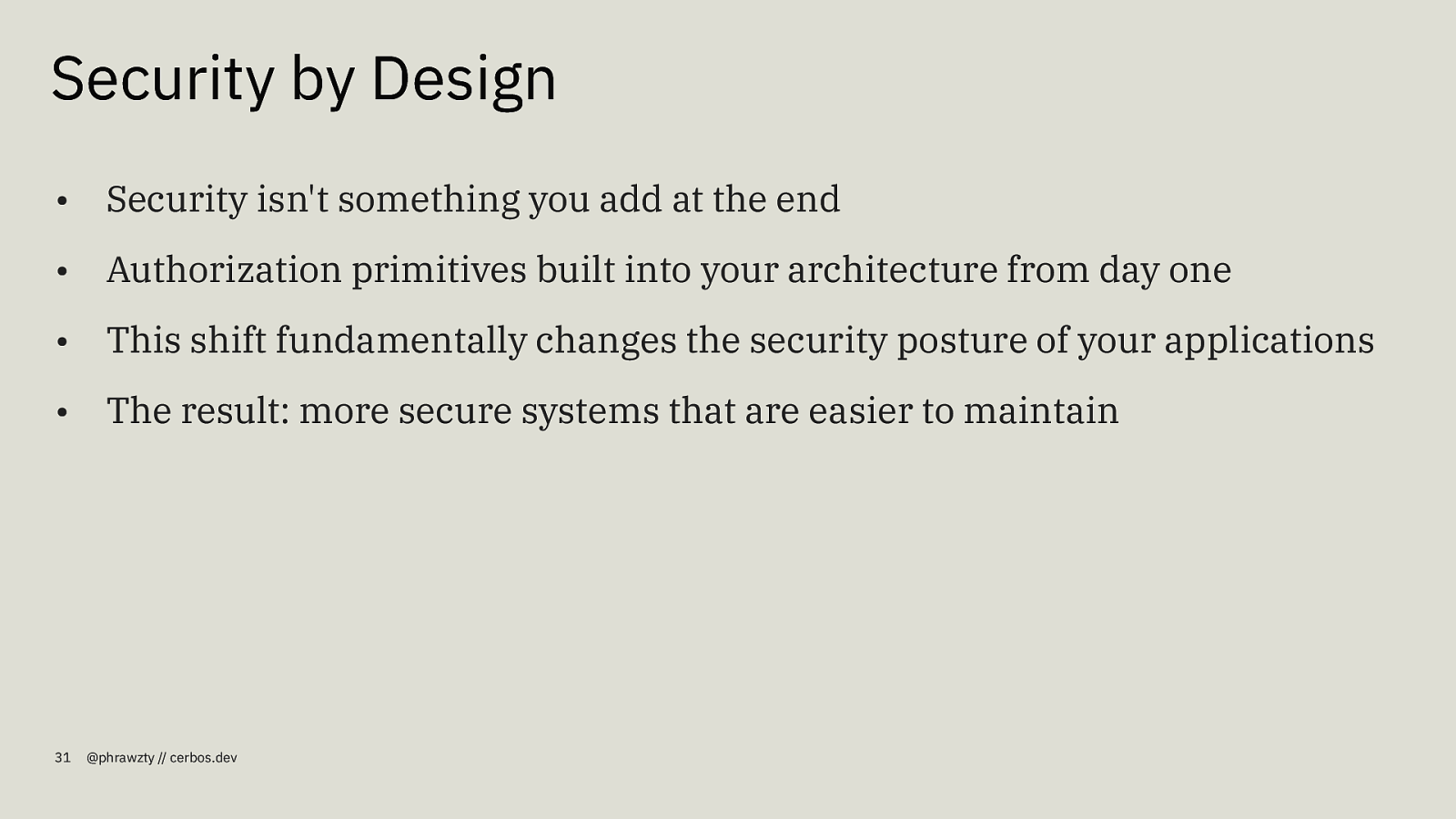
Security by Design • Security isn’t something you add at the end • Authorization primitives built into your architecture from day one • This shift fundamentally changes the security posture of your applications • The result: more secure systems that are easier to maintain 31 @phrawzty // cerbos.dev
Slide 32
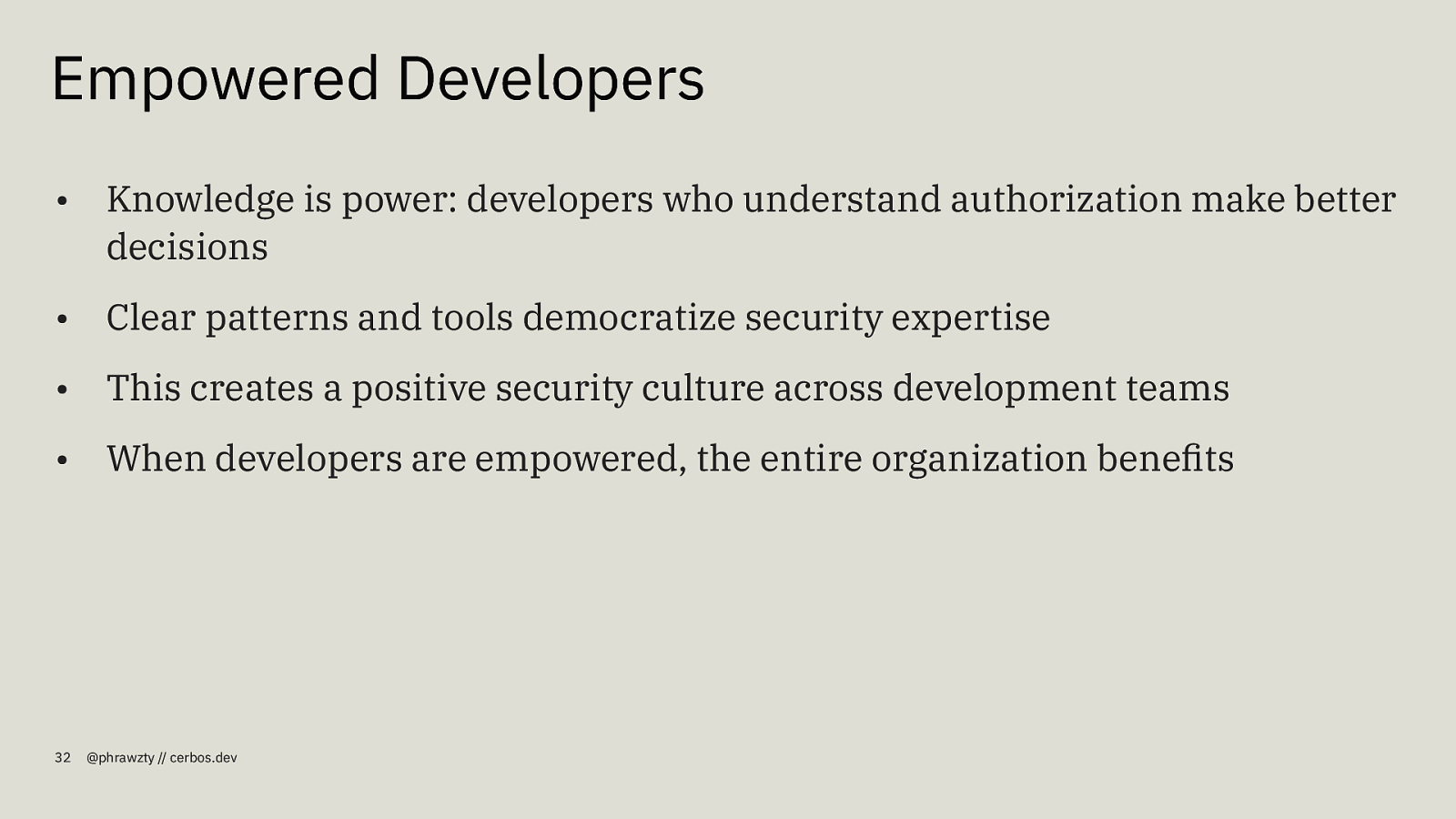
Empowered Developers • Knowledge is power: developers who understand authorization make better decisions • Clear patterns and tools democratize security expertise • This creates a positive security culture across development teams • When developers are empowered, the entire organization benefits 32 @phrawzty // cerbos.dev
Slide 33

Thank You • Authorization should enable great software, not hinder it • The tools and patterns exist today to transform your approach 33 @phrawzty // cerbos.dev